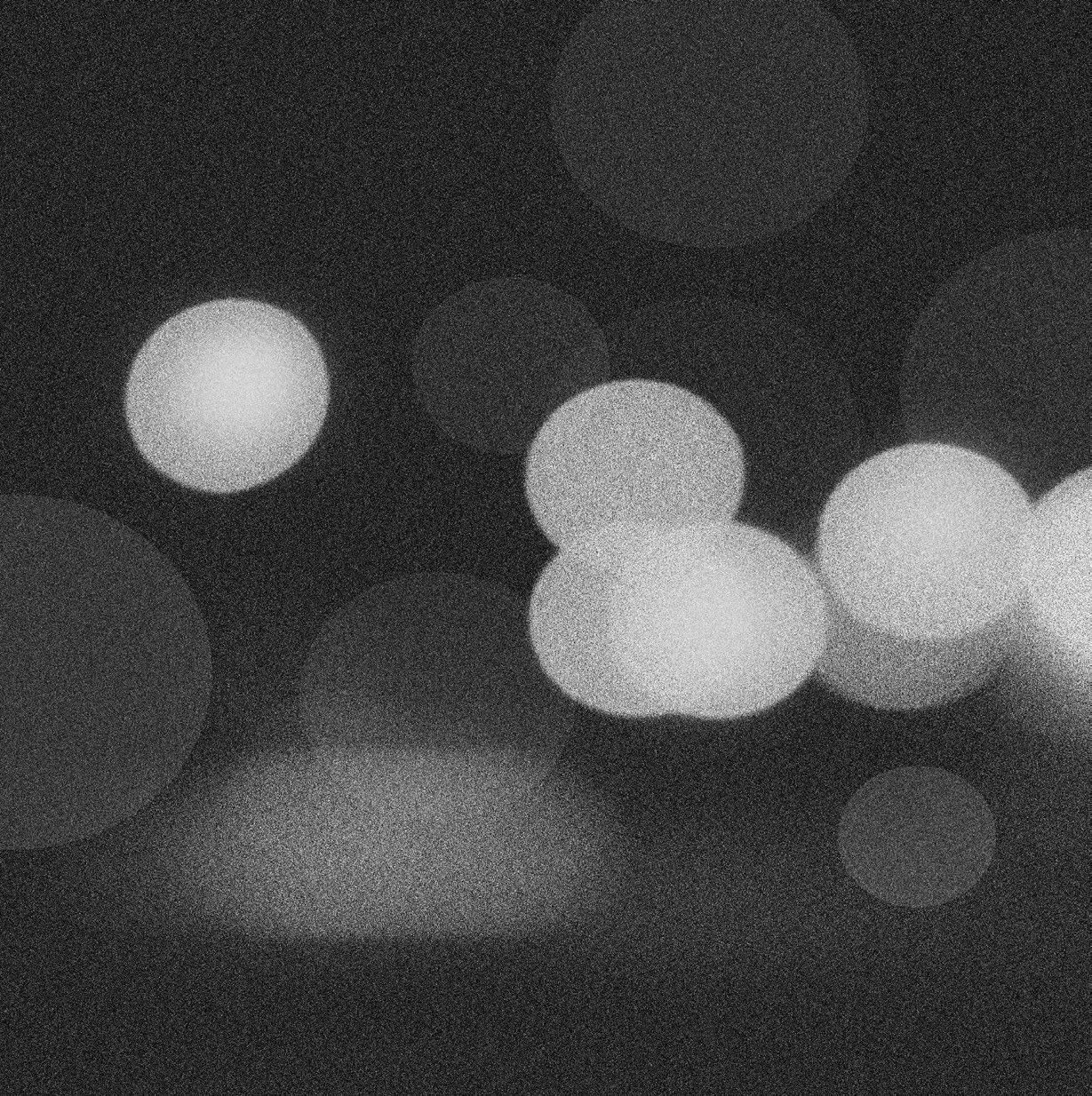IMPACT REPORT
JULY 2023 –JUNE 2024













JULY 2023 –JUNE 2024












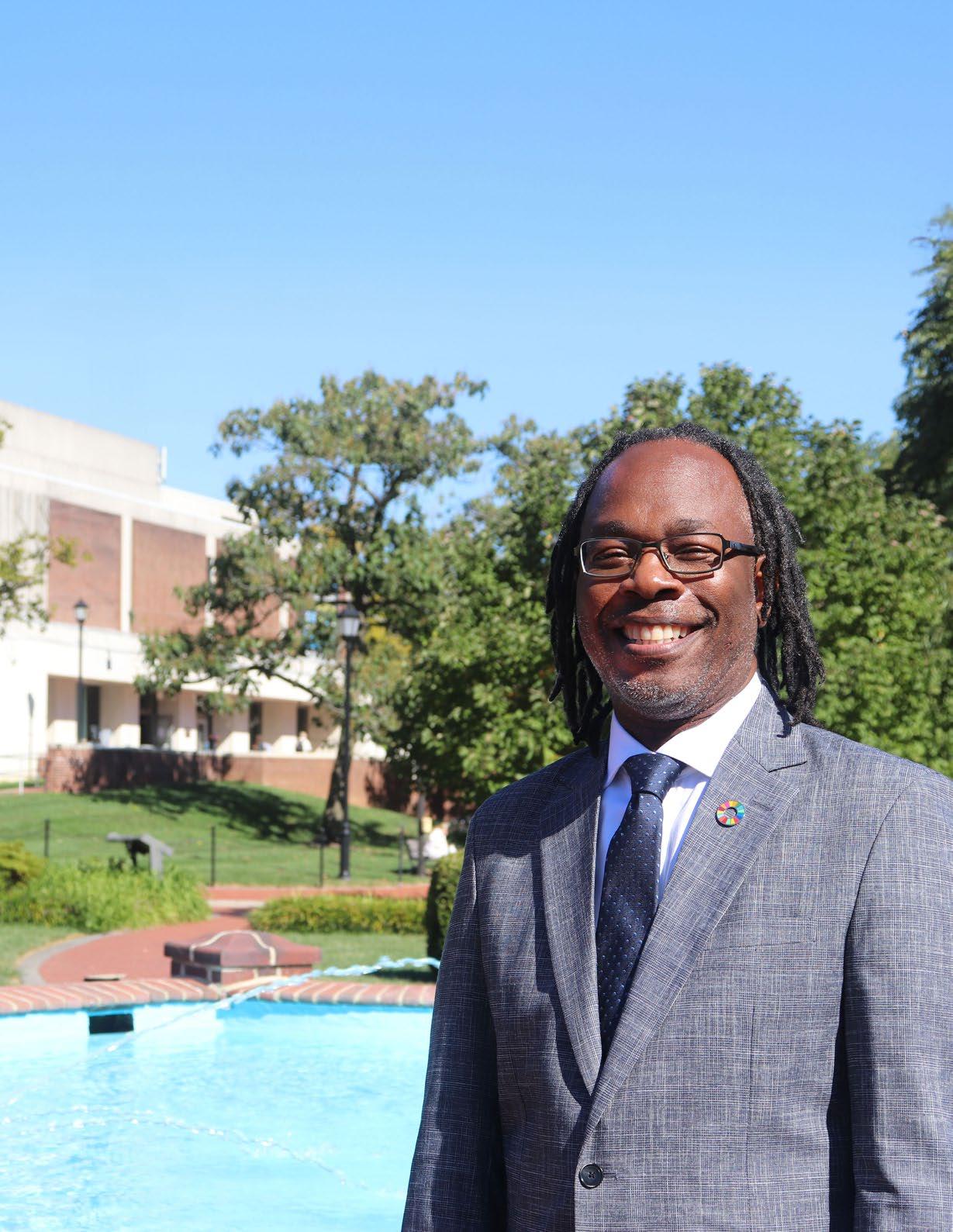
Trevor A. Dawes, vice provost for libraries and museums and May Morris University Librarian
Dear Friends and Colleagues,
I am pleased to introduce the Library, Museums and Press’ annual Impact Report, which highlights some of the incredible work our dedicated staff has accomplished over the past academic year. This report not only captures the core of our mission but also exemplifies the passion, creativity and commitment of everyone on our team. I am grateful to our staff for their dedication to leading meaningful and transformative initiatives in our community and beyond.
The feature stories in this year’s report serve as a testament to the diverse and rich programming Library, Museums and Press staff have brought to life. One standout project is “Poetry as Activism,” a Mellon Foundation grant-funded initiative which celebrates the intersection of art, activism and cultural expression. This initiative included a festival that created a space for voices from all backgrounds to converge and share their experiences and inspire change through poetry. Additionally, through the initiative we are making significant strides in digitization efforts, ensuring the preservation and accessibility of valuable cultural resources for future generations. These initiatives are crucial in our ongoing endeavors to push boundaries and engage with our community in innovative ways.
I am also proud to highlight the life and artistry of the late James E. Newton through a joint exhibition and partnership with the Delaware Art Museum. This collaboration not only celebrated Dr. Newton’s life and work, but also strengthened our ties with local institutions, fostering deeper community connections through art and education. The exhibition has been an inspirational platform, drawing diverse audiences and encouraging discussions around art, history and social justice.
Additionally, I am excited to share the success of the campus-wide Artificial Intelligence Teaching and Learning Workshop Series. This series offered invaluable insights into the rapidly evolving role of artificial intelligence (AI) in teaching and learning, equipping faculty and students with the tools and knowledge to navigate this emerging landscape. The Library, Museums and Press’ leadership in this initiative has been instrumental in shaping the future of learning at the University of Delaware, positioning us at the forefront of academic innovation.
Our special collections and museum colleagues have worked hard, strategically expanding their outreach to niche audiences and inviting them into our four gallery spaces. The intentionality of their efforts is an awe inspiring story of how our team has creatively and thoughtfully designed programs and welcomed collaborations that resonate deeply with the diverse communities we serve. Whether through targeted exhibits or specialized tours, our gallery spaces have become more inclusive and accessible to those who may not have previously felt connected to traditional special collections or museums offerings.
Our staff are deeply invested in advancing Open Access initiatives, central to our mission of sharing knowledge with the world. In the past year, we have openly shared 609 articles through our repository and have established new read-and-publish agreements with publishers such as the Royal Society of Chemistry and Springer Nature. These efforts, combined with publishing fee discounts with the Multidisciplinary Digital Publishing Institute (MDPI) and BioMed Central, have made it easier for our scholars to share their work widely and freely. Our commitment to open access guarantees that knowledge remains accessible to all, a critical component of our vision for the future.
On the technology front, our team has been working diligently to implement and improve the tools that support our mission. From the adoption of Alma as our new library services platform to the launch of UDStax, our chatbot; and from adding a language translator to our website to integrating to Occuspace and migrating to OpenAthens, we are staying at the forefront of digital tools that enhance access and usability for all. These technology improvements reflect our commitment to ensuring that our resources are easy to navigate and accessible to all members of our community.
Finally, our report highlights our investment in experiential learning opportunities for students, one of the cornerstones of our mission to foster the next generation of leaders and innovators. Through peer-to-peer reference programs, students co-curating exhibitions and hands-on learning experiences, we offer students the chance to gain invaluable skills while contributing to our work. These opportunities benefit the students and enhance the richness of our programs and initiatives by infusing them with fresh perspectives and energy.
As you read this report, please remember that it is only a snapshot of the incredible work of the Library, Museums and Press. We are deeply committed to continuing this momentum, and we invite you to engage with us—whether in person or online—to delve deeper into our initiatives and join us in shaping the future.
I am grateful for the unwavering support of our community, partners and staff, without whom none of this work would be possible. I am excited for you to read the report and discover the many ways we are making a difference, together.
Cheers,

Trevor A. Dawes, vice provost for libraries and museums and May Morris University Librarian
By Eric Ruth

His brilliant and brash art still holds the power to astonish, nearly three years after his death. His passion as a teacher and mentor endures in the hearts of countless Blue Hens, three decades since his start as a University of Delaware professor.
The man may be gone, his energy refuses to fade: It still has the strength to inspire people and to make connections between them, through the art that he loved.
Amanda Zehnder, chief curator and head of museums, could sense that power at the bittersweet campus symposium celebrating Newton’s life in 2023. Over at the Delaware Art Museum, Chief Curator Margaret Winslow also remembered the force of Newton’s vitality and she also believed it should endure.
Together, the two museum professionals decided to act: Let’s join hands and use Newton's power to create something good, something that will strengthen the sometimes tenuous
of Newton’s work—one in Delaware Art Museum, the others in UD’s own exhibit spaces—that highlighted his pointed perspectives on social justice and the lives of Black Americans.
But the ambitious exhibitions also served a broader mission, achieving a goal that has proved elusive over the years for the UD Library, Museums and Press: Energized by Newton’s still-thriving spirit, UD and the Delaware Art Museum began to embrace a fresh sense of commitment to one another and to communities they seek to serve.
“Throughout his career Dr. James E. Newton believed in the importance and interconnectedness of art, education, mentorship and community,” Zehnder said. “These exhibitions were exciting examples of a newly formalized partnership between UD and the Delaware Art Museum, and they allowed both institutions to reach a broad audience in Newark, Wilmington and beyond.”

Newton turned out to be the perfect person to help take this re-energized partnership to a new level. His dynamic presence in the Wilmington community is still felt by many: He helped create the city’s Mitchell Center for African American Heritage and served on the boards of the YWCA and the Delaware Art Museum.
“I really thought of him as a mentor and a colleague and a friend. He was amazing. He was the loveliest man,” said Winslow “Whenever he would call me, I would grab my pad of paper and get ready. He was so generous with his knowledge, sharing
constantly about art history and artists.”
“But he was also patient. He listened carefully, but he was candid, in the most supportive way possible,” she added.
Blue Hens who fell into his wide sphere of influence also treasure his memory and marvel at his tireless energy: They remember the art professor who would discuss Black history with them as they walked to class; the man who once stopped to console a stranger who sat weeping on a campus bench.
“He sat down and started talking to her and was able to straighten it out,” recalled his widow and wife of 54 years, La Wanda Newton. “He was truly that way. He would stay up late at night reading and writing, writing letters of recommendation for his students. I guess that's the reason students cared so much for him.”
That commitment is still felt at UD’s Department of Africana Studies, which Newton helped create years ago. “He was the consummate mentor for students,” said Kimberly Blockett, chair and professor at the department. “Students from all over the University came to him, especially Black students, because it wasn’t always a friendly place for them years ago. But they knew he had their backs and would point them in the right direction.”

Before he passed, Newton knew of the plans to honor him and, along with his family, he supported it. But the people who knew him sense he’d even be more pleased to see his work become the first major outcome of the newly formalized partnership—called a memorandum of understanding—between UD and the Delaware Art Museum.
And what a partnership it is becoming: The double-header art exhibits—one at the Delaware Art Museum, the other in Mechanical Hall—each spanned several months, involved hundreds of paintings and documents, and included dozens of skilled professionals in multiple states. At Special Collections, a third major Newton exhibit was created, this one focused on UD’s extensive archive of Newton’s poems and papers.
Departments across campus came together to lend their expertise to the project, including his beloved Africana Studies. Newton’s family also gave their support and advice, and people from inside and outside of campus eagerly joined the exhibit planning committee.
Then the real work began. Newton’s broad-ranging genius made it no easy task to encapsulate and celebrate his eclectic, socially incisive work. Planners had to open their arms wide enough to embrace an outsized impact, along with personal perspectives from the people he affected so deeply.
That became obvious at a symposium that celebrated Newton’s activism and art in the months following his death, said Curtis Small, manager for research services for Special Collections. “He touched so many people, he mentored so many people on so many levels,” Small said. “He was like a force in Delaware and beyond, not just an artist and teacher, but just a real pillar.”
Small and his Special Collections team made sure the Newton exhibits embraced ideas as well as art, exploring his work as an educator and his commitment to preserving and sharing Black history.
Meanwhile, Zehnder and Winslow
kept the Zoom lines between Wilmington and Newark buzzing with their efforts to coordinate and align complimentary art exhibits, in two very different spaces.
“She and I spent months and months reviewing his art,” Zehnder said. “He had this huge academic career, but he also always had an art career. That aspect is less well known than his work as an educator and a scholar. This project was meant to highlight those artistic accomplishments, which really hadn’t gotten the same amount of understanding.”
Gaining a more holistic perspective on Newton as an artist and scholar even meant reaching back in time— back to 1966 and to the campus of the University of North Carolina Chapel Hill, where Newton became the first Black graduate of its master of fine arts program.
UNC art history doctoral student Rachel Ciampoli could almost feel his presence return to that campus when she was enlisted to help with the curatorial process as a Delaware Art Museum fellow. Ciampoli specializes in 19th century American art and how it portrays issues of race, a topic that instantly resonated with the themes she saw in the art and poetry she helped uncover from Newton’s North Carolina years.
"We had a lot of overlapping interest in the way race is depicted,” Ciampoli said. “I think also the range of styles that Dr. Newton worked in was similar to that era. It was fascinating to see how he expressed different ideas in different media.”
As awareness of Newton’s legacy was being reignited in North Carolina, Winslow and Zehnder were slowly refining their selections, turning to the exhibition committee for crucial input on framing his work. The Delaware Art Museum zeroed in on his art from the 1960s and ’70s, while UD would cover the later years.
“My focus initially was his
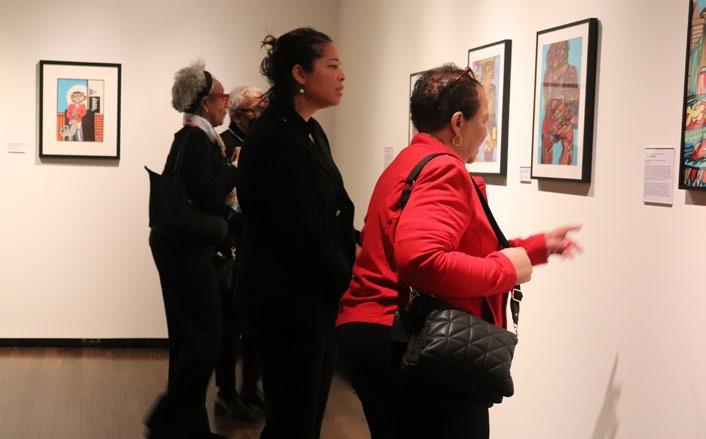
representation of faces and people as a unifying theme,” Zehnder said. “He was very good at drawing out a sense of character in his depictions of faces and people.
“But it was also important to bring in that sense of African American heritage and community, because that runs throughout his art and echoes his interests in other parts of his career,” Zehnder added. “He was a very serious person, with serious purpose, but we wanted to highlight his sense of humor.”
Ultimately, the curators were able to piece together so many themes that ran like undercurrents through his work: experimental techniques, three-dimensional art, and above all, the struggle for civil rights and social justice for all Black Americans.
“That was a constant, that commitment to social justice,” Winslow said. “Social justice was important to him in his art and in his activism throughout his whole life. You can really see how his style developed and jelled. You saw that beautifully in the exhibition at the University of Delaware.”
And you still see it on campus today, in the impact he had on Africana Studies and in the careers of his one-time students who would go on to become professors at UD. You see it in the symposium series that was launched in 2024 in his name and in the many academic honors that still bear his
name: the Excellence in Teaching Award, the Black Student Union Faculty Award and others that will forever be part of UD’s own legacy.
“He was truly, truly a very devoted man to what he was trying to do,”
La Wanda Newton said. “He just felt that many Americans were just not aware of the many contributions Black Americans have made. He just cared, he really cared about people and wanted the public to be aware of the contributions of Black Americans.’’
It’s enough to make many people conclude that James Newton’s spirit is most certainly still alive and well, whether they knew him or not.
“It’s made everyone even more eager to explore new ways of upholding the pillars of our partnership with the Delaware Art Museum: experiential learning, curatorial collaboration and community engagement,” Zehnder said. “Somebody once said we’re sort of like a front porch for the community, an entry point for the public. Our museums are public museums. We want the public to visit them and benefit from them.”
Ciampoli felt Newton’s spirit as well, in a way he probably would have loved.
“He sounds just like the kind of professor you always wish you had,” said Ciampoli.
Open access is revolutionizing the landscape of academic libraries and higher education, transforming how knowledge is shared and obtained. In an era where the cost of journal subscriptions and academic resources often restricts access to essential information, open access initiatives champion the fundamental freedom of knowledge. By spearheading efforts to provide free and unrestricted access to scholarly research, the Library, Museums and Press staff not only fosters innovation and collaboration for global researchers but also enhances the academic experience for students and faculty alike.
Our graduate students continued their work creating metadata and parameters for a new collection in UDSpace to house datasets about Library materials. This work allows researchers to interact with Special Collections materials in new ways. In December 2023, our first dataset on the Alice Dunbar-Nelson General Correspondence Network was completed and made available to the public, and has been viewed and downloaded more than 40 times. A second collection of text from Civil War diaries housed in Special Collections was also recently completed. This collection features memories of individuals who lived through and were involved in the Civil War, as well as recollections from a 19th century steamship engineer and member of the Delaware Quaker community. This work also helped educate and prepare our graduate student interns for careers that involve digital archiving and data curation.
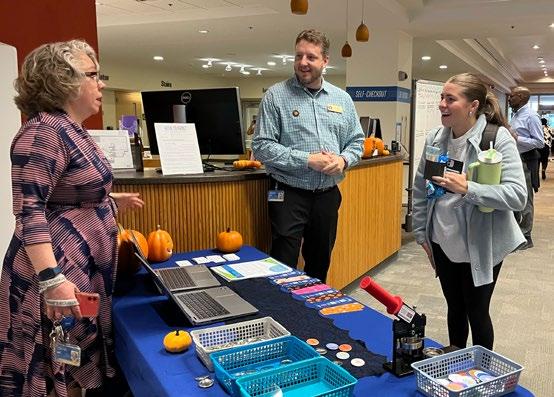
As part of our commitment to democratizing knowledge, 609 articles written by University of Delaware faculty were added to the University’s institutional repository, UDSpace. This marks a 15-fold increase in the average number of articles deposited annually in the last three years, compared with the average number added from 20042020. This is all thanks to targeted outreach to faculty, students and staff led by our digital publishing specialists. During the 2023-2024 academic year, there were a total of 3,644 views and downloads of these articles; and 33 UD faculty took advantage of our Open Access agreements with Cambridge University Press and the Royal Society of Chemistry to make their articles open access. The Library’s support for open access has greatly benefited the community, allowing the dissemination of UD research without placing a financial burden on our researchers.
This year, the UD Library, Museums and Press continued its leadership in promoting student access to affordable course materials through an $182,000 grant received from UNIDEL. This funding allows staff to expand the Library’s existing grant program which provides funds to faculty who replace their expensive textbooks with freely available open materials or Library-licensed content. Funds from UNIDEL have also been used to purchase Pressbooks, an Open Educational Resources authoring platform which launched to UD faculty in late 2024. Moving forward, the grant will allow staff to expand the community of advocates across Delaware higher education institutions to provide more resources for students, faculty and staff.
In a digital age, using technology to enhance user experience in academic research libraries has become paramount. Providing users with seamless access to resources, streamlining information retrieval and creating welcoming environments that promote exploration and collaboration are critical to our work. Below are a few ways the UD Library, Museums and Press staff have made user experience enhancements over the past fiscal year that not only support scholarly pursuits but also contribute to the overall mission of the University of Delaware.
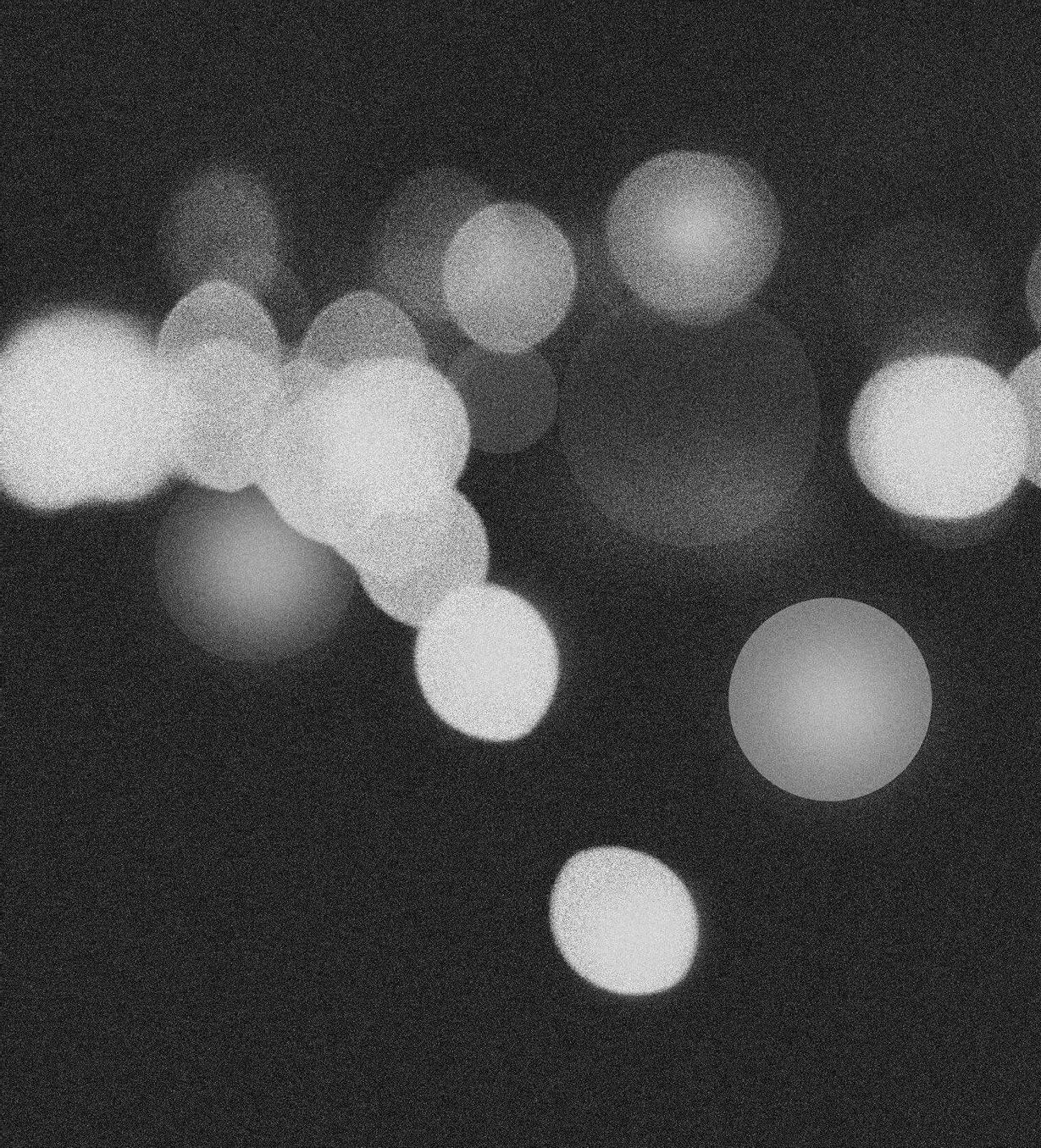

In January 2024, Library, Museums and Press staff from IT and the Learning, Engagement and Curriculum Support Division launched UDStax, an innovative AI-based chatbot designed to assist students, faculty and staff with general inquiries about Library services and spaces. This pilot project reflects the Library’s commitment to leveraging emerging technologies to enhance community support and expand access to services. With an accuracy rate that is now over 97%, UDStax provides 24/7 responses to frequently asked questions, covering topics such as Library hours, book location, study room availability and database access. The chatbot adapts to users’ language preferences and retrains itself daily using the latest Library content.
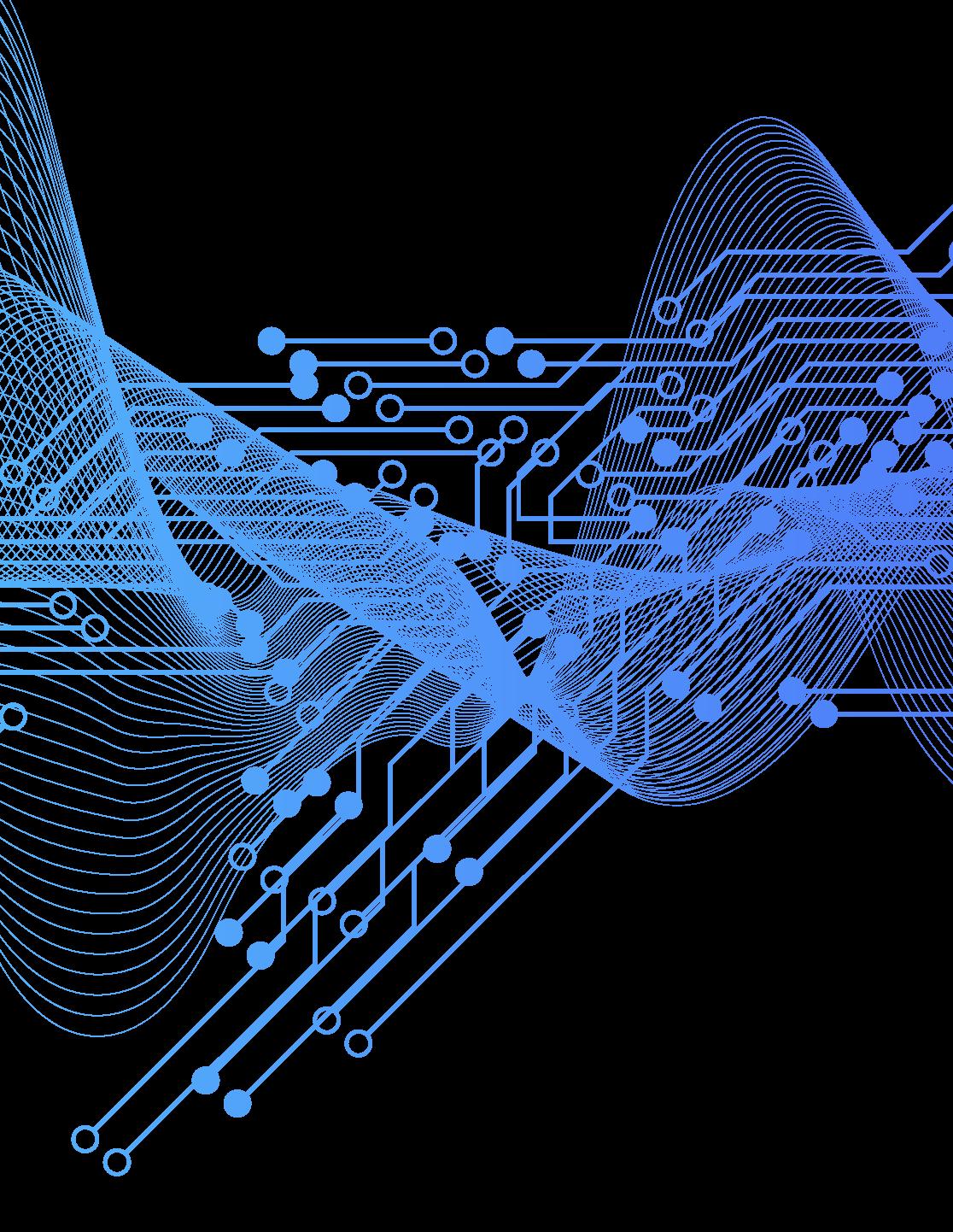
Stemming from a growing recognition of the University’s diverse student body, in January 2024, staff from Library Information Technology took a significant step toward inclusivity by introducing a new feature on its website: a language translator powered by the Google Translate plugin. This innovative tool utilizes the Google Translate API, enabling visitors to seamlessly translate the text content of all Library pages into their chosen language at the moment they access the site. With 104 languages supported, the Google Translate plugin represents a commitment to breaking down language barriers and ensuring that every student feels welcome and equipped to utilize Library services. Since its launch, a total of 68 users have accessed the language dropdown, exploring the Library’s offerings in 24 different languages. Curious of the most frequently translated languages? They include Chinese, Hmong, Japanese and French. In a world that is increasingly interconnected, the Library’s Google Translate feature is not just a tool—it’s a bridge that connects diverse voices and experiences.
In Fall 2023, the Library, Museums and Press partnered with Occuspace to install bluetooth sensors throughout Morris Library. These sensors work by anonymously capturing the number of devices within range and then translating this data into real-time estimates of patron occupancy in different areas. Using the Occuspace API, Library IT then created an Available Seats page on the Library, Museums and Press website to display the number of available seats throughout Morris Library. Patrons can filter and sort the list by floor, by alphabetical order of the name of the area in the Morris Library or by the most available seats to the least. Students love to use this visual information to decide when and where to use Morris Library spaces for group or individual study and collaboration. The different Morris Library areas listed on the page include information about the total number of seats, location (including a highlighted map) and even whether the area has natural light, is considered a quiet area or tends to be crowded. A version of the Available Seats page is also available on UDConnect, the University-wide mobile app. This technology is a game-changer for students seeking to navigate the often-crowded spaces of the Library.
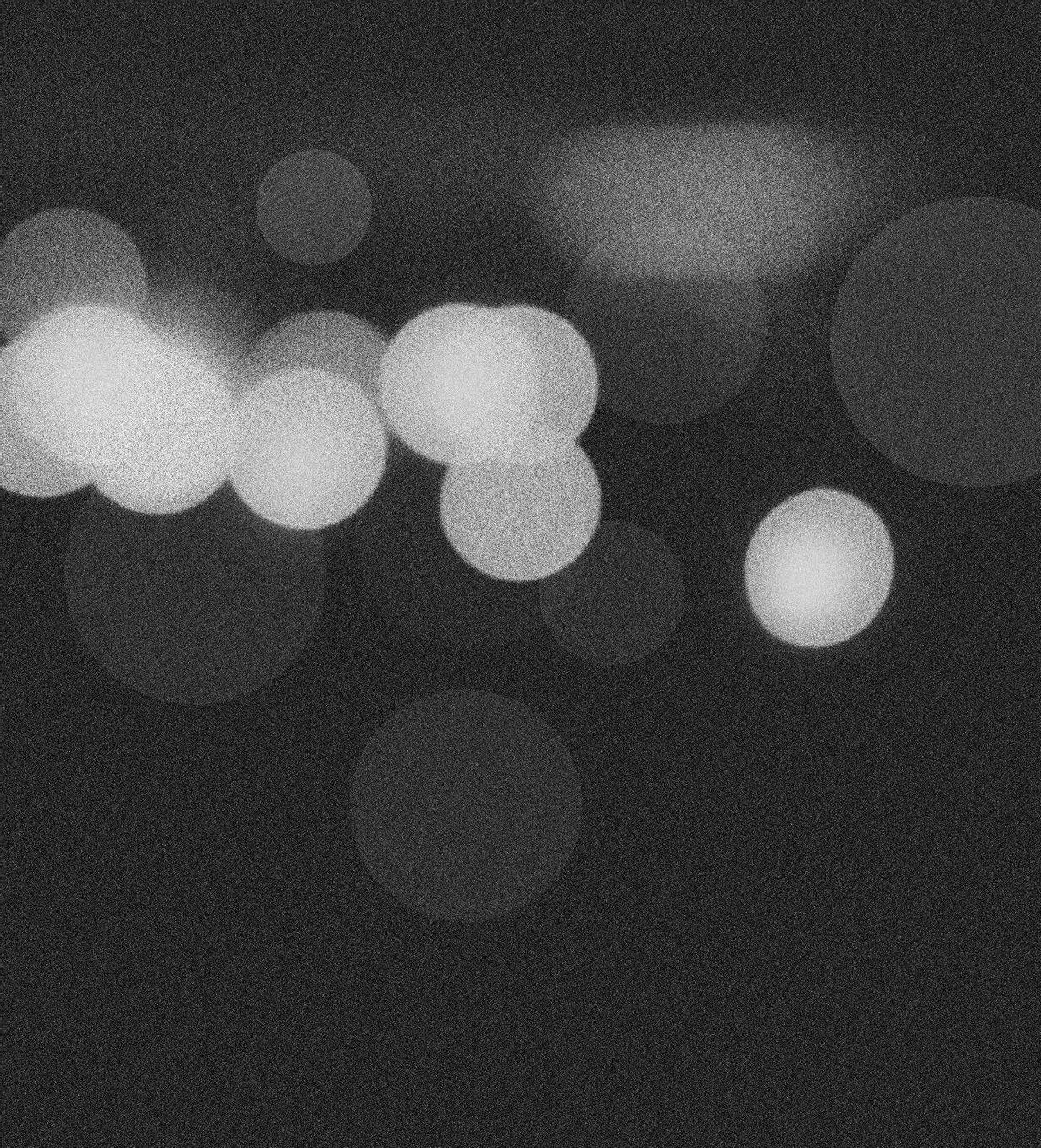
Since January, our patrons have been enjoying a more streamlined and efficient way to engage with our electronic collections thanks to the launch of OpenAthens—a transformative platform that provides seamless access to our extensive collection of electronic resources, including databases, electronic journals, newspapers and e-books. The platform not only serves as a secure access control mechanism but also offers valuable insights into the usage and demographics of our electronic resource users. One of the best features of OpenAthens is its ability to significantly enhance the user experience for patrons, making it easier to access essential resources while effectively addressing the challenges posed by paywalls. Library IT and Collections, Acquisitions and Resource Sharing worked together to make this project a success!
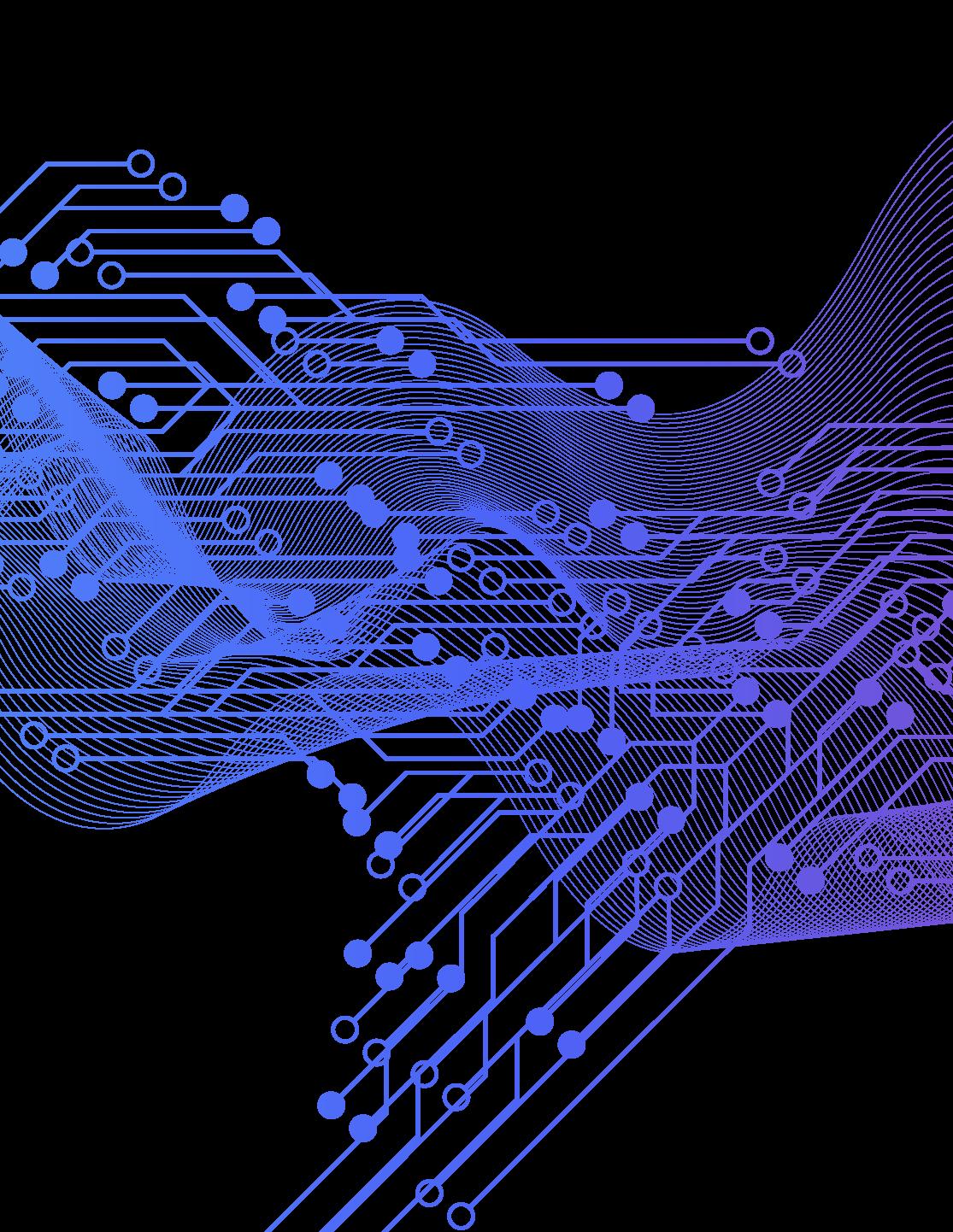
Last year, Library IT and Special Collections collaborated to enhance the user interface of our ArchivesSpace platform, significantly improving access to our distinctive Special Collections. ArchivesSpace is an open-source application designed to manage and provide access to archives, manuscripts and digital objects, supporting a wide range of archival functions. This upgrade replaced an outdated delivery system with a modern, regulation-compliant platform already adopted by numerous peer institutions. The new built-in public access features allow for instant publication of collection descriptions, eliminating the previous need for extensive reformatting and editing and greatly enhancing visibility and accessibility for our patrons. This advancement streamlines our internal workflows and facilitates easy updates and corrections, ensuring the information available to the public is accurate and current. With ArchivesSpace at the core of our manuscript processing and description efforts, the launch of the new public user interface represents a transformative milestone in how we manage and share our archival resources.
Throughout the 2023–2024 academic year, the Library, Museums and Press has offered Blue Hens a variety of hands-on, experiential learning opportunities so they may gain invaluable real-life training and education that will translate to further their education, careers and life after UD. Their work has also played an instrumental role in advancing our mission.
During the Fall 2023 and Spring 2024 semesters, four undergraduate students participated in the pilot of our Peer Reference Service by providing academic research support to their fellow classmates. These students completed an intensive eight-week online training course, developed by staff librarians, to become experts on the full range of services and resources offered by the Library, Museums and Press. In addition to coursework, the students participated in weekly group meetings to refine their skills, brainstormed marketing and outreach strategies and addressed any challenges they encountered. They also participated in tours of Morris Library’s Preservation Lab and Special Collections areas and met with various guest speakers who shared insights on their paths to librarianship. “I feel like I learned so much about the Library and in general,” said one of the students. “It is good to know the people who are working behind the scenes in the Library and who are here to help us.”
Each year our student assistants amaze us with their creativity, intentionality and thoughtfulness in developing ideas that uplight the entire UD Community. During UD’s Stress Less Week, which occurs right before finals, Arynn Hernandez brought some extra joy to Morris Library by creating visual reminders to display in the building. Suhas Cristy Mathey, a graduate student in computer engineering with an interest in film, edited videos for the exhibit “The Delaware Experiment: 100 Years of Study Abroad,” which celebrated Raymond W. Kirkbride and the anniversary of study abroad at UD. These are just two of the 121 students who worked with the Library, Museums and Press this year and provided a combined total of more than 24,000 hours of work that impacted every area of the Library, Museums and Press
During the Fall 2023 and Spring 2024 semesters, four staff members from the Student Multimedia Design Center and the Digital Initiatives and Preservation worked alongside 35 students from the Department of Women and Gender Studies students to bring a powerful mock trial of Darryl Hunt to life. From the very first idea to the final performance, staff worked with these Blue Hens, providing guidance and expertise every step of the way—brainstorming which multimedia visuals enhance the performance and the technical expertise needed to make it happen. Students walked away from the project with experience in creating background graphics and data visualizations using raw data—transforming statistics on exonerations in the U.S. into eye-catching graphics that were featured in the showbill. The result was a compelling, multimedia-driven experience that underscored the importance of justice and the fight for exoneration.
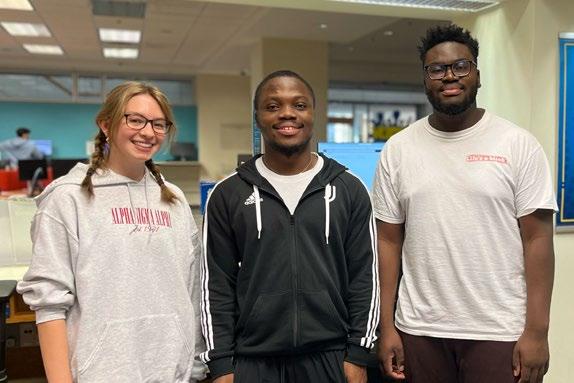
In December of 2023, Demetra McBrayer completed and made available a set of teaching materials designed to help students navigate the Alice Dunbar-Nelson’s Correspondence Network, allowing users to search DunbarNelson’s letters by date, location and the sender’s relationship to her. In addition to their work on Dunbar-Nelson, McBrayer played a leading role in organizing data from a collection of Civil War diaries housed in Special Collections which included memories of individuals who lived through and were involved in the Civil War. They also created a dataset from the Delaware Postcard Collection, which focused on geospatial data. McBrayer said they began all these projects with limited skills, but gained significant experience with the help of Digital Initiatives and Preservation staff. “My time with staff members in Digital Initiatives and Preservation gave me experience and skills that I can carry forward as someone interested in digital humanities work as a scholar and future humanities professional.”
In the spring of 2024, various UD students gained first-hand experience curating Special Collections and Museums exhibitions—offering the community a compelling look into cultural heritage, historical memory and the lasting impact of Black history and culture. Britney Henry, a doctoral candidate in the English Department and former Special Collections graduate assistant, curated the exhibit “Black Expression in Black and White: A Quest for National Identity,” which included newspapers, diaries and scrapbooks among its collection of materials from the 19th and 20th centuries to highlight the connection between Black publications and Black culture. Monet Lewis-Timmons, a Ph.D. candidate in the English Department and the museums studies program, curated the exhibit “Alice Dunbar-Nelson and the Legacy of Black Women’s Archives” showcasing materials from UD’s Alice Dunbar-Nelson papers among materials from other collections to show how these materials were preserved and publicized by later generations of Black women activists and scholars. Carolyn Hauk, a doctoral student in the Department of Art History, guest co-curated “The Artistic Legacy of James E. Newton: Heritage and Character Portraits,” on display in Mechanical Hall. The exhibit offered a closer look at Newton’s drawings, collages and prints as a window to explore and celebrate African American heritage, community and culture. Demetra McBrayer, a doctoral candidate in the English Department curated the four-case exhibition “The Artistic Legacy of James E. Newton: The Archival Record,” which explored the ways Newton built communities and changed the lives of those around him through his art and commitment to sharing Black history.
Graduate student Anukruti Pulimi worked as the Open and Affordable Teaching Materials Initiative Grant Coordinator this past academic year—which helps UD faculty locate free and low-cost resources to incorporate into their courses. Pulimi provided instrumental management support in this role by documenting the grant process, tracking project submissions, reaching out to stakeholders and keeping them informed and providing support for events and workshops. Pulimi also offered helpful suggestions to improve the initiative including using the Asana platform to streamline communication and project tracking; and collected and presented data to our working group to help inform their decision making throughout the process. “Anu is interested in being a business consultant, and she both brought and was able to practice skills related to consulting in this work,” said her supervisor Meg Grotti, associate university librarian for learning, engagement and curriculum support. “She learned our organization’s needs and the context of our program in order to ensure strong management of the workflows surrounding the grant program.”
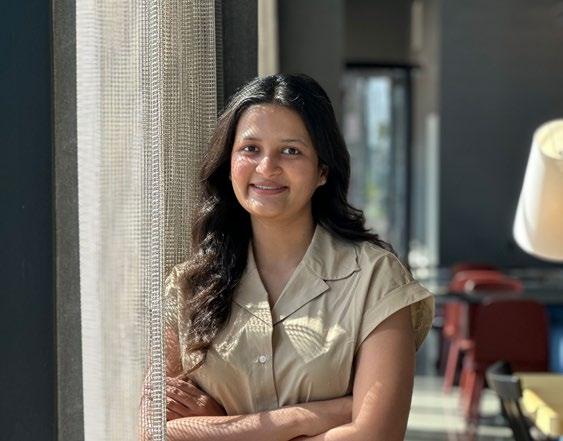
A new pilot program developed by our Museums staff gave Isabella Morais, a senior art conservation and art history student, the opportunity to gain hands-on experience in our Mineralogical Museum. During the internship, Morais played a pivotal role in redesigning and updating 1,000, outdated tags for the Permanent Mineral Collection. Morais helped to create clear, cohesive and informative labels that enhanced the visitor experience and ensured the accuracy and consistency of the collection.
By Carlett Spike
One of the main goals of the University of Delaware Library, Museums and Press Special Collections and Museums staff is to engage with various audiences and invite them to visit the gallery spaces and attend accompanying events on campus. The staff is small, but mighty in all the ways they support lifelong learning and help create an environment to foster curiosity for UD students, faculty and staff, as well as the broader Delaware community.
All four primary gallery spaces at the university—Old College Gallery, Mechanical Hall Gallery, the Mineralogical Museum and the Special Collections Gallery are free and open to the public. “We encourage people to drop in,” said Amanda Zehnder, chief curator and head of Museums. “We try to have an array of different programs and types of exhibitions to appeal to a wide range of people.”
But there’s so much more than just visiting and viewing the collections. “We hope to offer a gathering space for community events, classes and more,” Zehnder added. The staff is here to serve the community and can assist in a variety of ways from helping a professor build their syllabus around a collection or archive materials to curating popup exhibits or retrieving items in storage to meet special curricular needs. For example, in the fall and spring as part of Professor Tomé Salgueiro’s Social Entrepreneurship class, his students visited the museum to engage with our collections to explore the process of problem solving in action. “There are so many possibilities,” Zehnder added.
In the past year, staff from the Special Collections and Museums have worked with many community members to create exhibits, organize events and more.
It was a casual conversation that led a local Girl Scout Troop to visit Special Collections.
Graduate student Britney Henry, who was then working as an assistant for Special Collections, was speaking with one of the moms at the Fred Rust Ice Arena. The mom, who is a troop leader, got to talking with Henry about an exhibit she had curated on Black print culture. This moment sparked an idea—why not organize a field trip to see the exhibit.
“As someone who values outreach, I think it’s so important for those in our community to know about the collections that we have and to know that these materials aren’t just locked away for institutional access,” said Henry. “Anyone can come to Special Collections and see our collections.”
The group of about 20 preteens and parents spent an afternoon at Special Collections, where they explored Henry’s exhibit, titled “Black Expression in Black and White: A Quest for National Identity,” plus a handful of others. Special Collections staff also organized a few pop-up displays for the troop and gave them a tour into the stacks for a behind-the-scenes experience.
The visit was an exciting day, said Hillary Kativa, head of Special Collections. The troop was very engaged and inspired by their visit to Special Collections, she added.
This turned out to be a unique collaboration that truly highlights the vast variety of uses possible for Special
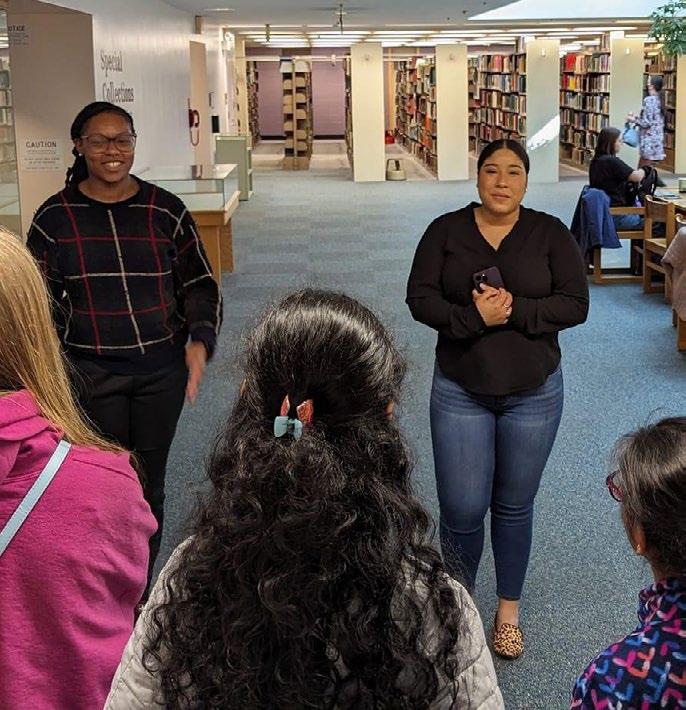
Collections. There’s a misconception that Special Collections are only for research purposes, Kativa said. “You don’t have to be a professional researcher to come in and engage with the materials or the exhibitions that we have. I like to say all you have to be is interested.”
The experience also reaffirmed why the staff does the work that they do. “The reason that we are collecting and acquiring these materials in the first place is for them to be used.” Kativa went on to add, “We’re not just here for the students and the faculty that we serve, but for the greater community as well.”
Can the gallery space in Mechanical Hall be used for a fashion photoshoot?
It was an unusual request, but one Lori Birrell was happy to receive. “We were thrilled with this question, and happy to say yes to this,” said Birrell, associate university librarian for Special Collections and director of Museums.
The request came from the UD Synergy Fashion Group, a studentrun organization that works together to execute a fashion show annually during the spring semester. Open to students of all majors, those who participate get hands-on experience in all aspects of the fashion industry from concept and design to fundraising and scheduling.
The theme for the photoshoot was “Living Art” so the group thought it would be a perfect opportunity to collaborate with the Museum to bring their vision to life. Birrell and the Museums’ staff worked with the students to make it happen.
“This was a celebration not only of the student work, but also a really wonderful pairing at the art gallery. There can be a perception that the galleries are only for students studying art history but these spaces, collections and exhibitions are truly for everyone. This was a wonderful collaboration that highlights the unique possibilities,” Birrell said.

As a veteran who served for 15 years in the U.S. Army, Senior Assistant Librarian Arline Wilson wanted to create an opportunity to celebrate the veteran community. She landed on organizing a free event that was open to the public titled “Honoring Our Veterans: Celebrating Community and the History of the Montford Point Marines.” The event, which took place Nov. 10 to coincide with the observance of Veterans Day, featured a presentation on the history of Montford Point Marines—the first African Americans to enlist in the U.S. Marine Corps—by Journalist Eugene S. Mosley.
Mosley, a member of the Montford Point Marine Association and author of Footprints of the Montford Point Marines, discussed the history of these soldiers and their impact on breaking the military’s racial barriers. Mosley’s book offers an in depth account of these marines experiences, as his father, Thomas Mosley, was one of the Montford Point Marines. In addition to the discussion, Mosley signed books, and Special Collections staff collaborated with the Friends of School Hill Association (FOSHA) to curate an exhibit celebrating the lives and military service of veterans in Newark’s New London Avenue community that was available for attendees to explore.
The event was incredibly well received, said Hillary Kativa, head of Special Collections. “I think for a lot of the veterans who attended, the event offered an opportunity for them to share their stories and learn more about the history of these marines,” she said. “It really sparked some wonderful feedback and conversation.”
It also gave UD’s ROTC students a chance to get involved, as they opened the event with a flag ceremony. “It was really nice to include the students and to see that connection between our ROTC students and the veteran community,” Kativa said.
Early in the fall and spring semesters, UD’s international students and their families received a special invitation for an event to visit one of the Library, Museums and Press’ gallery spaces after hours. This night at the museum, organized in collaboration with the Center for Global Programs and Services, offered international students a unique experience to engage with the Museums and get a sneak peak of what the University has to offer.
In the spring, students were invited to tour the exhibit “Building a Collection For Teaching: Helen Farr Sloan’s Gifts to the University’s Museums.” The exhibit included a selection of the nearly 1,400 artworks that Farr Sloan donated to the University. “The collection specifically highlights academic museums and how they work, so it’s a wonderful introduction to what people can learn from the Museums,” said Ashley Rye-Kopec, curator of education and outreach.
In addition to the tour, students were able to explore on their own and were given a snack voucher. The international students who attended said they appreciated this event and having exclusive access to explore a collection. There were 50 visitors in the fall and 80 visitors in the spring. Rye-Kopec also points out that there have been repeat visitors, a positive indicator that people really enjoy this event.
“Our goal is to help international students feel welcome as they acclimate to campus,” Rye-Kopec said. “This event is not only a great way to introduce them to the Museums and our resources, but also helps to foster relationships with students and their families.”
High school students who are accepted into the Delaware Governor’s School for Excellence program spend one week on UD’s Newark campus to see what it would be like to be a college student. Those who chose to pursue the visual and performing arts track of the program, visit UD’s Mineralogical Museum. Their assignment is simple: They each get to choose their favorite minerals to illustrate.
“It’s a fun exercise and exciting to see what the students come up with,” said Sharon Fitzgerald, curator of the Mineralogical Museum. “Minerals are very complex looking and very difficult to draw. It’s just wonderful to see how easily they can create these beautiful works of art,” she said adding “it’s just mind boggling.”
Throughout the class, students share their drawings with one another and Fitzgerald to get feedback. As a former gemologist, Fitzgerald particularly loves that this activity merges science and art in a unique way to get students to consider a broader perspective of what’s possible for them in higher education.
“I just enjoy it so much, and they do too,” Fitzgerald said.
These are just a few examples of ways to collaborate with the Museums and Special Collections. To get started, Zehnder always suggests visiting the website to explore past exhibits and reaching out to bring any ideas to fruition. “We’re always happy to respond to questions and help organize exhibitions and events,” Zehnder said.
Margaret D. Stetz, Mae and Robert Carter Professor of Women’s Studies and Professor of Humanities, and Mark Samuels Lasner, Special Collections senior research fellow, curated the exhibit “Max Beerbohm: The Price of Celebrity,” which was on display at the New York Public Library from October 2023 to January 2024. With the help of our staff, the exhibit largely featured items from the University’s collections. More than 37,000 people visited the exhibit during the three months it was on display, and the gallery is still available online to explore.
1,051
STUDENTS ENGAGED WITH SPECIAL COLLECTIONS THROUGH CLASS INSTRUCTION SESSIONS
1,141
STUDENTS VISITED THE MUSEUMS FOR CLASS-RELATED ACTIVITIES
- Africana Studies - Art - Art Conservation
- Art History
- Chemistry - Dance - English - Entrepreneurship - Fashion - First Year Seminar - French - History - Italian - Marine Science
- Material Culture Studies
- Military History Studies
- Museum Studies
- Music - Physics - Spanish - Women’s Studies
In response to the ongoing conflict in Gaza, staff member Jeanne Kambara and our IDEAS Committee recognized the urgent need to support student voices advocating for change The “Let Your Voice Be Read” event was a letterwriting table activity designed to teach and empower students to communicate with their representatives. A total of 30 Blue Hens participated in this meaningful activity, learning how to effectively search for their representatives and address and draft a letter about their specific concern. Students were provided with free stamps, envelopes and an instructional, letter-writing packet This initiative not only facilitated student advocacy but also educated participants on a critical global issue. To further staff awareness, the IDEAS Committee released two internal documents: resources on the Israel-Hamas war and a glossary of relevant terminology
Author and historian David W. Blight delivered the keynote address about the life and impact of Frederick Douglass to an audience of UD students, faculty, staff and community members at the University and Whist Club of Wilmington during the Friends of the University of Delaware Library’s Annual Dinner on April 4. Douglass wrote 1,200 pages of autobiography, edited newspapers for nearly two decades and wrote thousands of speeches. Blight has authored or edited a dozen books including a biography that has won nine book awards like the Pulitzer Prize. Before and after his talk, Blight signed copies of Frederick Douglass: Prophet of Freedom. Blight ended the evening answering questions from the audience, eager to learn more about the great 19th-century abolitionist.
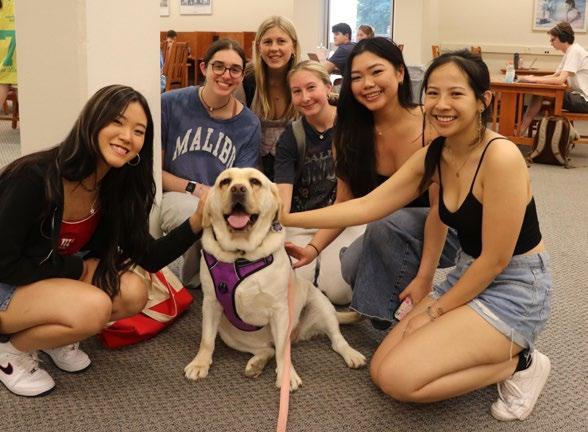
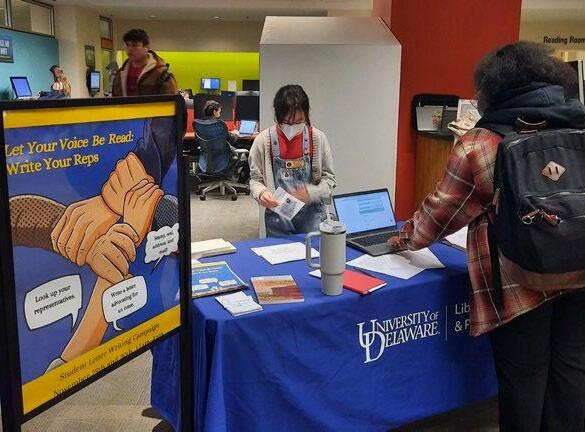

During finals week at the end of every fall and spring semester, staff from the Library, Museums and Press’ Communications and Events Team turn the usual pre-finals stress into a more enjoyable experience for our dedicated Blue Hens. From crafting buttons to petting dogs—complete with coffee and cookies—we offered a variety of relaxing activities to help ease the last-minute cramming for final exams and placing the finishing touches on research papers.
From October 2–6, 2023, the UD Library, Museums and Press was proud to celebrate Banned Books Week, highlighting the importance of our freedom to read and the harms of censorship. The week’s programming included a series of table events about the history of censorship including the censorship of LGBTQIA+ materials, young adults and children’s books, and within public libraries. The Blue Hen community and beyond were invited to stop by our informative tables to learn about the historical context of book bans and censorship legislation. Of course, the main event was our 11th annual Banned Books Read-Out which gathered rebel readers to speak out against censorship and celebrate the books that have been challenged or removed from schools and libraries.
On November 10, 2023, Morris Library buzzed with excitement as over 65 guests came together for a powerful Veterans Day event honoring the Montford Point Marines. Attendees were captivated by Eugene Mosley’s inspiring talk, which brought to life the remarkable legacy of these trailblazing veterans. The event also included a pop-up exhibition in the Morris Library Reading Room, honoring this community’s long legacy of military service. The atmosphere was further elevated by the proud presence of UD’s ROTC cadets, who served as color guards, adding a touch of solemnity and honor to the occasion.This event was made possible through a dynamic collaboration with the Friends of School Hill Association and Special Collections staff and reflects the success of an inaugural partnership with the Blue Hen Veterans Organization and UD’s ROTC Battalions.
On August 28, 2023, more than 50 first-year students gathered in Morris Library for our “First Day Q&A” panel discussion in collaboration with the Office of Academic Enrichment. The event had a 900% increase in attendance and featured three faculty members who work closely with undergraduate students across various disciplines, alongside three Blue Hen Ambassadors. The energy in the room was high as students eagerly engaged with the panelists, sparking insightful conversations and forging new connections. This event was the perfect kickoff to their academic journey!
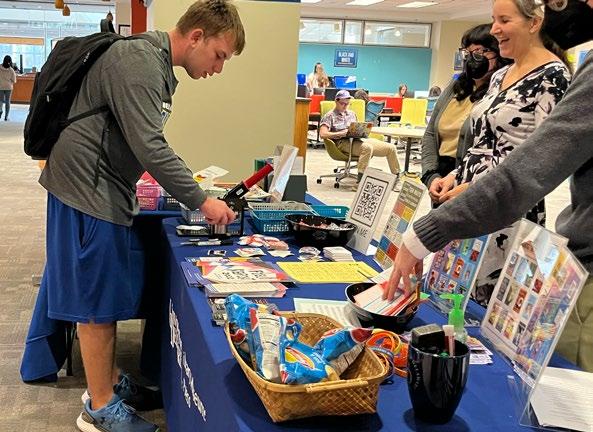
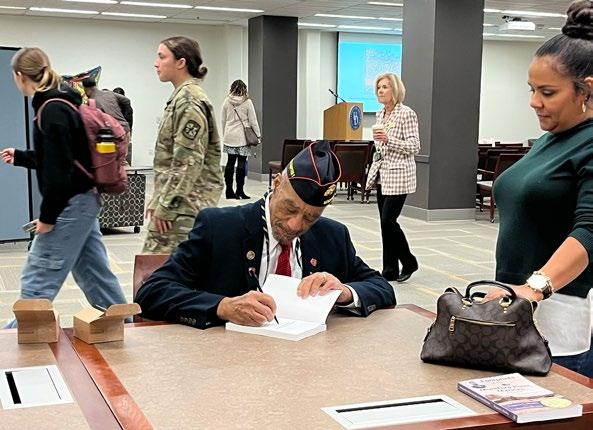

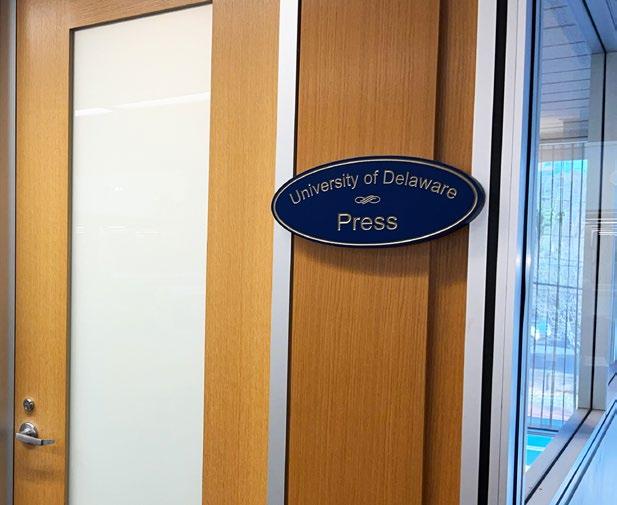
As an Introductory Member of the Association of University Presses (AUPresses) since 2019, the Press has not only navigated the challenges of the publishing landscape but has also positioned itself for significant growth and impact. Established in 1937, AUPresses is a beacon for more than 160 presses worldwide, advocating for the interests of its members and fostering collaboration across the academic publishing community.
Membership in AUPresses offers invaluable resources, from an online hub for resource-sharing to career development opportunities and data-driven insights. Introductory Members benefit from access to these resources while working toward the full membership goal. In 2023, the addition of a Publishing Coordinator enabled the Press to meet the staffing requirements for full membership. That same year, University of Delaware Press Director Julia
Oestreich began serving on the AUPresses Library Relations Committee, where she works to enhance collaboration between university presses and academic libraries. Through her involvement, Oestreich has engaged in initiatives that promote innovative solutions to common challenges.
In January 2024, the culmination of all of these efforts was celebrated when the AUPresses voted to accept the University of Delaware Press’s application for full membership, granting it the ability to participate in organizational decision-making on key issues that affect university presses, such as advocacy initiatives, best practices and emerging technologies.
The University of Delaware Press’s full membership is not just an accolade; it is a testament to the Press staff’s dedication to advancing scholarship and fostering collaboration within the academic community.

THE UNIVERSITY OF DELAWARE PRESS’ PUBLISHED BOOKS BETWEEN JULY 1, 2023 AND JUNE 30, 2024:
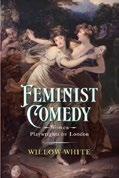
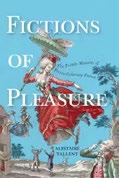

In December 2023, the University Press secured funding from the National Endowment for the Humanities (NEH) Open Book Fellowships Program to digitize and make freely available Hostile Humor in Renaissance France by Bruce Hayes. The Press was eligible for the grant since Hayes was awarded a separate NEH grant to conduct research for the book and the Open Book program provides funding to make NEH-supported research openly available to the public.
“When we learned about the NEH Open Book Fellowships Program, we immediately recognized an opportunity to advance our open access profile,” said Julia Oestreich, press director. “Bruce Hayes was enthusiastic about the prospect of making his book freely available, understanding the importance of reaching a wider audience. His letter of support for our grant application reinforced our collective commitment to this project.”
Since the grant announcement, the response has been overwhelmingly positive. Press staff have actively promoted this achievement through social media platforms and at conferences throughout the year. This outreach has sparked inquiries from both existing authors interested in open access options for their works and prospective authors curious about our strategy, as the Press has begun publishing selected new titles on an open access basis. Interest in Hostile Humor in Renaissance France has also been revived, highlighting the potential for academic dialogue and public engagement that open access publishing fosters.
Prior to this grant, the Press had published one open access title thanks to the generosity of UD Library, Museums and Press donors and other institutional support, and plans for at least three more open access titles to be published in the 2024–2025 academic year. Additionally, the UD Library, Museums and Press’ Digital Initiatives and Preservation Team has worked with University Press staff to digitize and make several backlist titles available through the UDSpace repository.
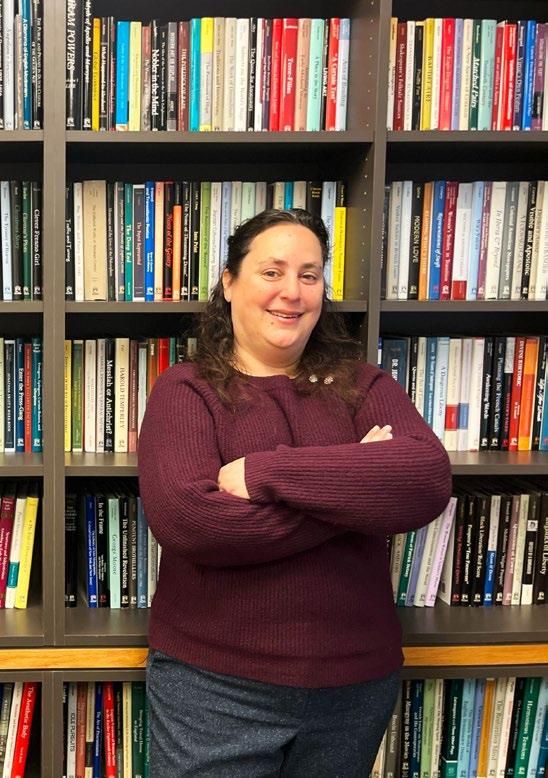

Literature and the
Complete Writings and Selected Correspondence of John Dickinson, Volume 3
Edited by Jane E. Calvert (February 2024)
Objects of
Redreaming the Renaissance: Essays on History and Literature in Honor of Guido Ruggiero
Edited by Mary Lindemann and Deanna Shemek (May 2024)
Student collaborating at the Student Multimedia Design Center.
The UD Library, Museums and Press staff play a vital role in fostering academic success and engagement with Blue Hens by providing rich resources, diverse programming and supportive spaces that enhance learning and intellectual exploration. Collectively, our staff are not only enriching the academic experience for UD students but also cultivating a sense of community.
The new Passport Program was designed to help introduce transfer students to the Library, Museums and Press. As part of the UNIV 120—Transfer Transition Seminar, students participated in a self-guided scavenger hunt through Morris Library and its virtual services. This interactive activity encouraged students to explore key areas of Morris Library, including the Help Center, Special Collections, the Ask the Library online service, the Student Multimedia Design Center and other locations throughout Morris Library to answer questions and get clues. This past academic year, the Passport Program helped orient more than 150 transfer students. Feedback from students was positive with many reporting that it helped them get acquainted with the Library and offered an opportunity to engage more with their classmates.
Peer-to-peer learning is a well-researched teaching method that enhances academic engagement and success amongst students. In the fall of 2023, the Library, Museums and Press put that research to practice by identifying, hiring and training four UD students to provide general reference services throughout the past academic year. This peer-topeer reference program included one-hour weekly meetings to practice, learn and meet people across the institution. During the fall 2023 semester peer-reference Blue Hens answered 41% of all patron questions submitted to the Library, Museums and Press followed by 37% during the following spring 2024 semester. These questions included research information, technical inquiries, general Library information, and directions.

In the summer, 30 students participated in the UD Envision program, a National Institute of Food and Agriculture (NIFA)funded initiative aimed at training the next generation of agricultural scientists. As part of the program, students collaborated with Library, Museums and Press Student Multimedia Design Center staff to create videos that complemented their research projects. Many Blue Hens began the two-month program with little-to-no video experience, but by the end they had mastered how to use video equipment, learned various editing techniques, honed their storytelling skills and gained expertise in how to find and film content. Students explored a range of topics in their videos from the behavior of insects to the difficulties farmers have faced due to climate change. The final videos were presented and distributed at the Delaware State Fair and uploaded to YouTube to be viewed by a broader audience.

The new ENGL 110 Learning Module was developed in response to a Spring 2023 assessment of student and instructor needs, conducted by our First-Year Experience and Student Success Librarian. The assessment highlighted two key findings: instructors valued online teaching materials, and both instructors and students identified source evaluation as a significant challenge in the research process. To address this, and in collaboration with the Library’s online learning librarian, an online tutorial was created to help students understand different types of sources and learn to analyze the relevance and credibility of sources for use in their research papers. Since its creation, more than 130 students and instructors have accessed the module.

A UD faculty member’s interest in fanzines (zines) led to a collaboration between the Center for Material Culture Studies and staff members from Special Collections and Research and Engagement to create an interactive zine program for prospective students during Decision Day 2024. The group organized a display of zines covering topics like racial and transformational justice, body image and music; added a new Zine Resources section to the current Material Culture online library research guide; and produced a zine about the Center for Material Culture Studies to hand out to students. The program offered prospective students a chance to learn more about material culture by exploring and researching zines, while also showcasing the depth of the Special Collections archives and the wealth of educational experiences awaiting them at the University of Delaware.



By Eric Ruth
Looking back over the 2,700-year history of libraries, it certainly seems that one thing is long overdue: Praise for all those librarians who kept us in step with the march of technology.
Again and again, these unsung heroes have faced the forces of disruption and prevailed: In the late 19th century, they concocted the Dewey Decimal system to impose order on a ceaseless torrent of books. At the start of the internet age, they tamed the unruly rivers of electronic information, pulling us all closer to the knowledge needed to excel.
Now, as the somewhat intimidating presence of artificial intelligence peeks over the academic horizon, the librarians at the University of Delaware are handling this latest technological upheaval in the same way they always have: Engage with it fully, understand it completely, then find ways to make it work for the benefit of us all.
Over the last two years, dozens of Library, Museums and Press staff members have been at the forefront of a systematic campaign to prepare for—and capitalize on—the arrival of AI in academia. Seminars for faculty were launched, an AI chatbot for the Library’s website was born and those crucial conversations about AI’s pedagogical potential—and peril—are now well under way.
In a world that seems to be pressing the accelerator firmly toward light speed, UD’s librarians knew there was little time to waste.
“When we learned about ChatGPT in November of 2022, we instantly started playing with it, like we explore any information tool,” said Meg Grotti, associate university librarian for learning, engagement and curriculum support. “The implications of this were apparent right away.”
Before the arrival of large language model tools like ChatGPT, scholars and librarians could be reasonably certain about the source of the information, and thus its credibility. “AI was going to be pretty different and that was pretty clear the minute we started playing with it in my team,” Grotti said.
“That led us to ask ourselves a question: Where are we and where do we fit into this as librarians? And the answer was, ‘Wow, does this campus need us right now. This is our moment.’”
Quickly, a multifaceted campaign to proactively integrate AI began to gain momentum in the Library. In the spring of 2023, Grotti jumped at the chance to be co-convener of a grassroots “AI for Teaching and Learning” working group, which would later be formally tasked by the provost to examine AI’s role in the classroom. At about the same time, Vice Provost for Library, Museums and Press
asked an interdepartmental Library team to begin work on its AI-driven “UDStax” chatbot, overseen by Annie Johnson, associate University librarian for publishing, preservation, research and digital access.
In the early months of 2024, after weeks of training on how to respond to those after-hours queries, the chatbot was launched, giving students an around-the-clock tool for navigating Library resources.
“We started working as a team, with librarians and IT staff coming together to create a chatbot that is informed by the type of questions that we see already from students,” Johnson said. “Training was a huge undertaking, and when we started, the chatbot’s accuracy rate was pretty low. We worked to improve that by continually refining our prompts, by refining the knowledge base, and testing it with new questions.
Leading this work was Colleen Estes, coordinator for web support and development, and Beth Twomey, the Library’s head of research and
engagement. The team would discover that, along with training the chatbot to answer questions correctly, they must also teach it to refrain from answering some questions.
“We were worried about the chatbot saying something that was inappropriate or offensive or biased,” Johnson said. “Luckily, we really didn’t see that at all. And we even had UD researchers try to prompt it into a biased answer. The chatbot didn’t fall for it. That was good.”
Today, UD stands as one of just a handful of university libraries that have launched an AI-based chatbot, Johnson said. “So we’re really in unique company,” she noted. “We hope to share what we’ve learned with other academic libraries across the country who are also interested in experimenting with AI.”
As the chatbot project progressed, Grotti and Joshua Wilson, associate professor from the School of Education, were busy putting together a series of seminars designed to introduce faculty to AI’s strengths
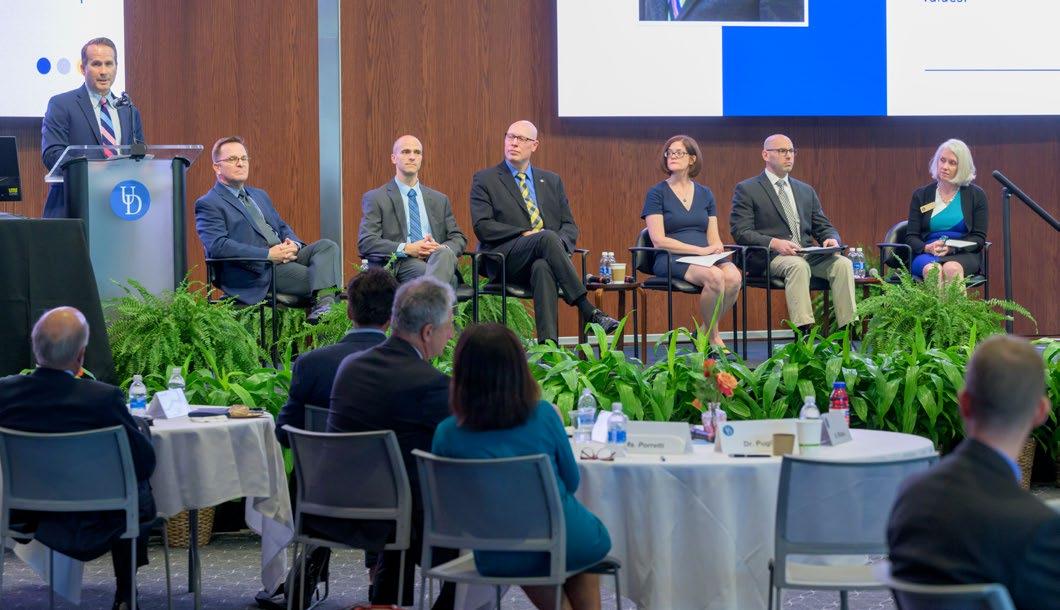
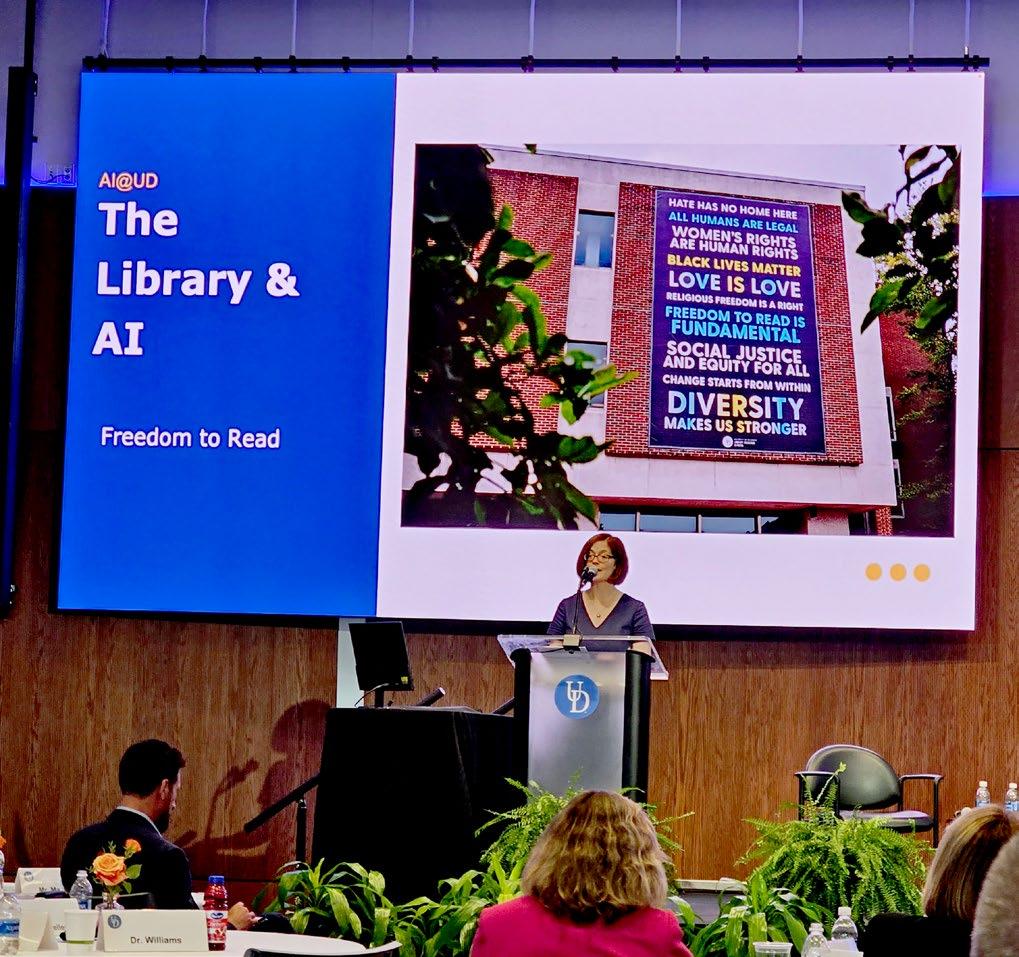
and limitations. Hosted by the Library, the seminars tackled everything from plagiarism and privacy to copyright and intellectual property. Ultimately, the seminars would reach 130 faculty members, or roughly 10% of the University’s full time faculty. More seminars are in the works and these will be even more focused on specific faculty needs and concerns, Grotti said.
Around the same time, the Library began a series of workshops for both faculty and students that covered AI’s potential as an academic tool. Maria Barefoot, UD’s online learning librarian, led the creation of an AI Literacy Tutorial that teaches students about fact-checking outputs, avoiding
plagiarism and optimizing AI for the types of tasks it does best.
Lauren Wallis, first year experience and student success librarian, led “Beyond the Hype: Using AI Ethically and Effectively” for the Spring into Success student conference hosted by Orientation and Transition Programs. In this workshop, students explored the basics of how generative AI works and analyzed capabilities and limitations of popular AI tools. Already, there’s potential for the work that was kick-started by the Library to positively impact the way AI is used, not just in Newark, but around the state and country: Grotti is part of a nationwide project started by Ithaka S+R , a nonprofit service that
helps the academic communities navigate economic, technological and demographic change.
The Ithaka project, which includes 18 other universities, aims to assess AI’s impact on higher education so that schools can make evidence-based, proactive decisions about how to manage the technology’s far-ranging effects. In the first phase of that project, Grotti and her team first asked faculty members to help define what “AI literacy” even means and how ready they were to teach it.
In the second phase, the UD team interviewed faculty about how they are using AI in teaching and research: What are the challenges? What resources do they need?
The results will ultimately help guide the adoption of AI not just at UD, but in schools across the state and around the country. And no matter where AI takes the world, it’s clear that libraries
need to be part of the journey.
“Libraries have a vital role to play in this, and add an important perspective,” Grotti said. “We’re not there to serve a specific discipline, to have a specific disciplinary lens. We’re seeing it more holistically, which I think really can help in those interdisciplinary kinds of conversations.”
In years past, libraries have played a powerful role in issues of privacy, intellectual property and copyright issues. That expertise seems likely to become more crucial—and even more vexing—as AI works its way into more classrooms.
“AI challenges those roles in some really interesting ways,” Grotti said. “But we will learn, we will adapt and we will find new ways of ensuring that knowledge is shared equitably and beneficially—just as libraries have always done.”
• Implications of AI on Training the Next Generation of Human Resources Professionals
• A Hands-On Workshop: Using Generative AI Tools for Optimizing Writing & Research
• AI-Powered Career Advancement: Navigating Career Preparation, Recruitment and Lifelong Learning
• Ethical Use of AI Tools for Research and Publishing
• Beyond the Hype: Using AI Ethically and Effectively
• AI and AI – The Intersection of Artificial Intelligence and Academic Integrity
• AI and the Future of Higher Education
• Navigating the AI Landscape: A Framework for Evaluating Assessment Tools in Higher Education
• Pitfalls and Promise: Generative AI, Disability and Access Ethical Considerations in AI
• AI Literacy and Tools: Managing AI Use in Your Classroom Session
• AI 101: Intro to Generative Artificial Intelligence
• Teaching AI Literacy in Research and Writing
By Carlett Spike
Beginning in the 1960s, poets Diane di Prima and Amiri Baraka (then LeRoi Jones) took the helm as editors of “The Floating Bear,” a newsletter created to connect poets and visual artists to share their work. Throughout its 37 issues, the newsletter featured a collection of poetry, articles, reprints, translation and artworks that covered a variety of topics from everyday reflections to political calls to action. Among the many talented artists who contributed were Anne Waldman, Victor Hernandez Cruz, Allen Ginsberg and Charles Olson.
“The Floating Bear” is just one of the many materials that have been digitized as part of the UD Library, Museums and Press’ Poetry as Activism Project.
Made possible by a $250,000 grant from the Mellon Foundation’s Public Knowledge Program, the Poetry as Activism project supports the curation and stewardship of poetry archives related to 20th-century poet-activists of color. The goal of the project is to examine the role that activism has played in the lives of poets and their work over time while also explaining the notion of poetry as activism more generally. “We are grateful to the Mellon Foundation for helping us bring these important materials to a wider public. Through digitization, we have been able to make new connections across collections, bringing poets in conversation with one another,” said Annie Johnson, associate university librarian for publishing, preservation,
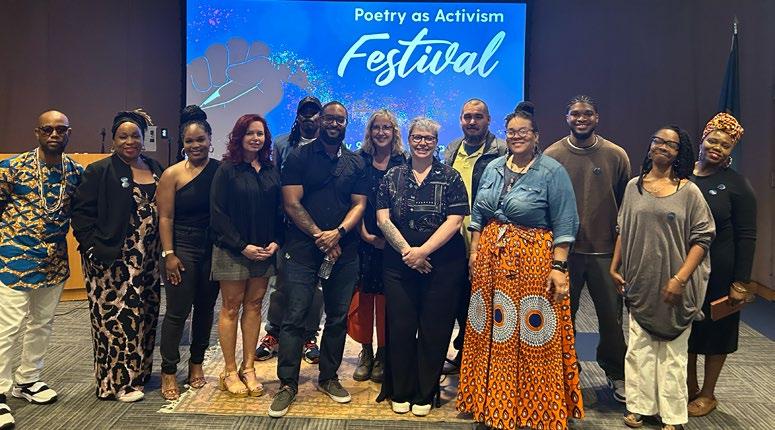
research and digital access.
Johnson is co-PI on this grant along with Lori Birrell, associate university librarian for special collections and director of museums.
To accomplish this, the project was broken down into three phases, said Jeannette Schollaert, who was hired as project manager to oversee the Poetry as Activism project. In January 2023 the first phase began by exploring the archives and digitizing the materials. Among the Special Collections archives were works from Toni Morrison, Ishmael Reed and Ntozake Shange.

“It was really a wonderful way to put my existing enthusiasm for American literature and activist movements to work on a specific university’s collections,” Schollaert said. She particularly enjoyed coming across
small intriguing details, like a letter in the Ishmael Reed papers that referenced Morrison’s fruitcake recipe.
For phase two, the university’s inaugural Poet-in-Residence Traci Currie was brought onto the project to engage with the Special Collections archive and create new works during the spring 2024 semester.
A Jamaican American poet, Currie is the state coordinator for Poetry Out Loud Delaware. She brought more than 20 years of experience in the communication studies field to the project through her work as a spoken word artist, mixed media artist-activistmulti-disciplinary facilitator, youth arts program director and college professor. Currie’s work focuses on compassionbuilding by creating inclusive environments in exclusive spaces.

For the Poetry as Activism Project, she sought to unpack the question what does it mean to be a community? as a guide throughout the process. “I saw this residency and project as an opportunity to bring in the community and connect them with the work and passion of my heart, which is poetry,” she said, noting she was inspired by the Black Arts Movement.
Currie’s multifaceted role began by delving into Library’s Special Collections. She read works by impactful poet-activists to better understand the tradition of performance poetry and how the practice has transformed our lives. “I’ve been reading about how their work is preserved and how it’s still alive today and impacting us in 2024,” she said. She also visited a variety of classes on campus to discuss poetry and activism in action with students, performed at a variety of events including the Improv Concert in the UD Music Department and offered a safe space for the community to share their own poetry. For example, through her role with Poetry Out Loud Currie invited youth in the program to present their poetry at UD events. She also facilitated a Poetry as Activism Workshop which was open to the public and offered another space for attendees to discuss, craft and perform poetry. It got to the point where she was nearly performing and holding events weekly, Currie said with a laugh.
Currie also drafted her own original poetry and writing which focused on Delaware’s spoken word scene in the ’90s. For this she interviewed seasoned artists to share their stories. In her writing, she connected these stories with the present day poetry scene. “It allows some accuracy and truth telling around the thriving essence of spoken word poetry and writers, as well as gives a voice to the people who have been doing this artist-activist work for a long time,” she said.
Her residency culminated with the Poetry as Activism Festival, which was co-organized by Currie and Schollaert. The early May event
held in and around Morris Library invited the community to explore the digitized materials, perform and partake in a poetry showcase as well as participate in discussions about archiving activism. One of the Poet Laureates of Delaware Twin Poet Al Mills and Maiss Hussein, winner of Delaware’s Poetry Out Loud student competition, were among the poets who performed. For many, the celebration offered a unique space for the community to share their stories.
“Poetry as Activism is a reminder that we are not a silo and we can’t do things by ourselves,” Currie said. “There are so many stories and voices that go unheard, and the Poetry as Activism Festival gave the opportunity to really shine the light on them,” said Hussein. “There were perspectives being shared that truly allowed me to digest what it’s like being in another person’s shoes.” She added that the event was refreshing and served as a good reminder of the power of poetry. “Poetry is, and always will, serve as activism,” she said. “It’s not just a set of words in a stanza, but the meaning and depth that differentiates it.”
The theme of community connection was an intentional piece of the Poetry as Activism Project that also led to a number of collaborations with professors. The project worked with Rutgers Professor Mary Rizzo to bring her Chicory Revitalization Project— which digitized Blatimore’s Chicory magazine and explored the city’s Black
arts activism—as a pop-up exhibit to Delaware’s campus. UD English professor Davy Knittle structured a portion of his course syllabus around the Chicory pop-up exhibition, as well as one of Currie’s performances. These partnerships even extended to unexpected places at times, said Schollaert, who added that the project also worked with Geography Professor Lindsay Naylor. Her students had the option to pick and engage with three curated items from the Poetry as Activism project for the course. “It’s really cool to see different approaches to teaching poetry as activism and I can’t wait to be surprised by folks who bring different kinds of movement aspirations to the project and to see where they take it,” Schollaert said. The final phase of the project is releasing an edited collection featuring the digitized materials as well as essays by leading scholars and poets. It will be published by the University of Delaware Press next year. Although the project is almost complete, Schollaert said she’s excited to see what new avenues are unlocked as people explore the archives.
She added, “I specifically see this publication as another invitation to come back to Special Collections and to be in touch with the librarians and staff here at UD Library, Museums and Press and continue engaging in the project.”
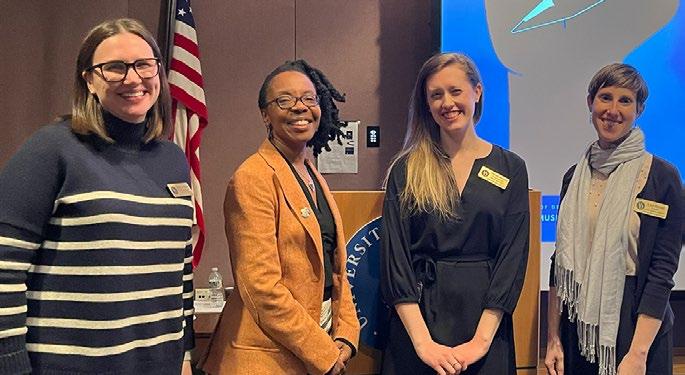
The University of Delaware Library, Museums and Press staff’s unwavering commitment to the academic and scholarly community is bar none. With an intentional strategic vision and a mission-focused approach, they create and provide access to exceptional services, initiatives and expertise for both the University of Delaware and the global research community. Whether authoring or publishing scholarly works; teaching new skills or designing new learning materials; cataloging, preserving and showcasing cultural heritage; making information and data freely or digitally accessible to all; or working behind-thescenes to ensure philanthropy, technology, patron service and communication is topnotch; their contributions are vast, far reaching and impactful. The success of their collective efforts is a testament to their relentless pursuit of academic and scholarly excellence that is diverse, equitable, inclusive, justifiable and accessible. This year, in addition to the usual updates on new hires, transitions and retirements, we would like to spotlight a few more remarkable members of our strongest asset—our extraordinary staff.

This past fiscal year, the Collections Sharing and Delivery achieved a significant milestone: officially receiving their millionth request at Morris Library since 2008. How did they do it? The team provides easy and timely access to resources using one of five distinct services— InterLibrary Loan (ILL), Article DELivery Service, Associate in Arts Program Delivery, Distance Learning DELivery Service and Office Delivery. Thanks to these services, UD students, faculty and staff can access a wide range of materials, including books, journal articles, DVDs and more. The Library, Museums and Press interLibrary loan service connects our Blue Hen community to a global network of libraries, allowing for seamless borrowing and engagement with a wealth of resources.
Last year, Jeanne Kambara joined the Library, Museums and Press staff as our Pauline A. Young Resident and Open Educational Resources Publishing Librarian. This prestigious three-year residency supports recent graduates of library education programs, providing invaluable early career development and professional work experience within an academic research library. Kambara holds a bachelor’s degree in English and history from West Virginia University and a master’s degree in Library and Information Science from Syracuse University. They bring a deep commitment for supporting people from diverse backgrounds and creating affordable and equitable resources to the role. In their first year, Kambara helped publish an open textbook by Associate Professor of English Meg McGuire, and managed the launch of a new grant program that supports faculty who want to author their own open education resource.
Recognizing the challenge of searching for and navigating through grant applications, a few years ago the Library, Museums and Press Development Ambassadors set out to empower staff with the skills and knowledge to secure funding and change the overall apprehension of the grant writing process. The group created in-house policies and procedures and developed a seven-part grant writing workshop series. This past year, the group’s initial efforts paid off with staff securing nearly $1 million in grants. This achievement reflects the staff’s dedication and the power of collaboration—proving that, even in the face of budget constraints, a committed team can unlock significant opportunities for growth and innovation.
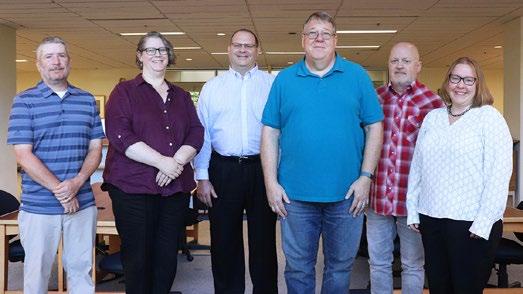
The Library, Museums and Press DELCAT Implementation Team received the University of Delaware’s Distinguished Staff Excellence Team Award this past spring for their remarkable efforts in transitioning the DELCAT online catalog to the new Alma platform. This ambitious 18-month project involved a variety of tasks including developing training programs, collaborating with various units, establishing new standards and refining workflows. Their work has provided equal access to a vast catalog of academic resources for both those on campus and the broader global community.
Last year, the Digital Initiatives and Preservation Team collaborated with many other higher education institutions and the non-profit Ithaka S+R to publish an insightful report titled, “The Research Data Services Landscape at US and Canadian Higher Education Institutions.” The report offers a comprehensive overview of the landscape of data services offered across different institutions, which are often siloed. The findings highlight the critical need for effective communication, coordination and collaboration. Building on this research, the Team will generate a UDspecific report aimed at strategizing the most effective ways to support our researchers in the future.
Among the many lost items that end up at the Help Center, an engraved Gallaudet College class ring with an amethystcolored stone turned up in May of 2023. Library Services Coordinator Cindy Bailey took up the case and decided to reach out to the school’s alumni office, but she hit a dead end. Months went by and it still bothered Bailey that she couldn’t find the ring’s owner, so she decided to try again. This time she connected with a Gallaudet librarian who spent several hours flipping through the 1984 yearbook to match the initials on the ring to women in the class. This time they got a hit and Bailey was able to return the ring to the Blue Hen who lost it. The best part: The ring belonged to the student’s mother who passed away when she was a child, so this was a piece of
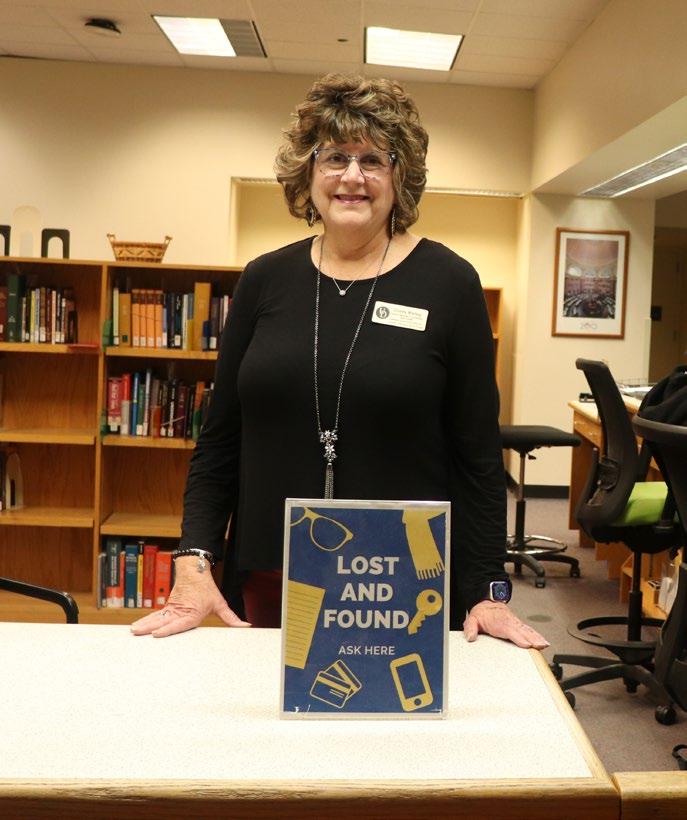
Jessica Berkana, Assistant Librarian and Coordinator, Acquisitions Services, January 22, 2024.
Annie Abrams, Library Assistant II, October 1, 2023.
Bob Tolliver, Librarian and Foundational Sciences Librarian, October 1, 2023.
Samantha Garlock, Assistant Librarian and Special Collections Cataloger, October 1, 2023.
Hillary S. Kativa, Associate Librarian and Head, Special Collections Department, September 18, 2023.
Holly Deakyne, Affiliate Senior Assistant Librarian and Political Papers Archivist, September 1, 2023.
Jeanne Kambara, Pauline A. Young Resident and OER Publishing Librarian, August 1, 2023.
Yuqiao Brigitte Cao was promoted to Assistant Librarian and Visual Literacy Librarian and Museum Educator, January 1, 2024.
Leif Erickson was promoted to Senior Electronic Resources Specialist, November 1, 2023.
Petra Clark was promoted to Assistant Librarian (working title: Instruction Librarian), August 1, 2023.
Valerie Stenner was promoted to Library Assistant III, August 1, 2023.
Tyler Walls was promoted to Library Assistant III, July 1, 2023.
Katelyn Leonardi was promoted to Library Assistant III, July 1, 2023.
Jennifer MacDonald was promoted to the rank of Librarian, July 1, 2023.
Amanda McCollom was promoted to the rank of Associate Librarian, July 1, 2023.
JP Mongeau was promoted to the rank of Senior Assistant Librarian, July 1, 2023
Aretha Black, Service Coordinator, Public Services and Space Planning, Office of the Vice Provost, March 2, 2024.
Shwu Leung, Systems Programmer III, Library Information Technology, February 2, 2024.
Carmen Smith, Administrative Assistant II, Office of the Vice Provost, February 1, 2024.
Pauly Iheanacho, Business and Economics Librarian, Research and Engagement Department, January 1, 2024.
Timothy Murray, Librarian for Delaware and 19th and 20th Century Print Collections, Special Collections, September 16, 2023.
Daron Harper, Library Assistant II, Multimedia and Access Services Department, July 1, 2023.
Peggy Tatnall, Library Services Coordinator I, Multimedia and Access Services Department, July 1, 2023.
The Library, Museums and Press appreciates all of our generous supporters who enable us to inspire the intellectual and creative achievements of our Blue Hens through expert staff, dynamic learning spaces and access to world-class collections and resources. We are especially thankful for our Carillon Circle donors who have committed to legacy gifts through their estates; our True Blue Hens, who make consecutive, annual gifts at all giving levels; and our Delaware Diamond Society members for their leadership support. Lastly, we are grateful to the entire Library, Museums and Press staff who go above and beyond each year serving as champions and ambassadors for our crowdfunding initiatives.
With your support, last year we expanded the availability of freely and digitally available open access materials for researchers, facilitated student curated exhibitions of Special Collections and Museums materials in our gallery spaces and increased access and discoverability of our physical and digital collections.
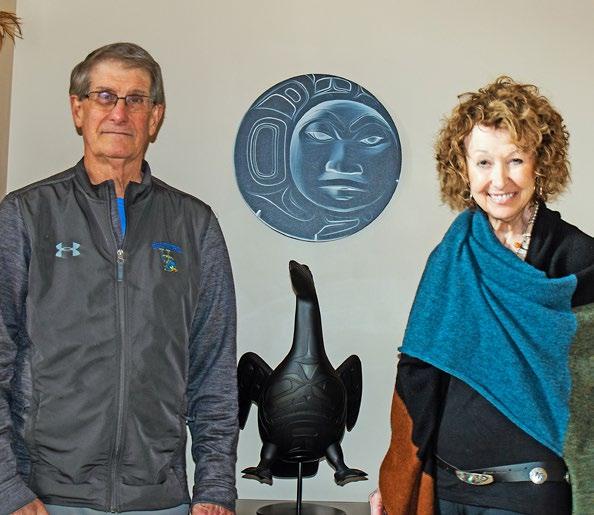
Col. W. Eric Roberson is a UD alumnus, UD ROTC Commissioned Officer and dedicated Fightin’ Blue Hens football fan and supporter. But that is not where the support for UD ends for Eric and his wife, Judith.
The Robersons are known for their major collection of Native American artwork. A section of their collection was highlighted in the Library, Museums and Press 2022 exhibition “Grounded Innovation: Pueblo Arts of Clay” held in Old College Gallery. The exhibition, which featured more than 50 works of Native American pottery loaned from the Robersons, focused on modern Pueblo artists and how they innovated to strengthen bonds with their ancestors and homelands.
In 2023, the Robersons modified their already established legacy commitment to the University by splitting the $583,000 gift to also financially support the efforts of the University Museums. The modification also included gifting their extensive collection of Native American Pueblo Art to our museums. The collection, which includes pottery, paintings, textiles, bronzes and kachinas (small carved wooden dolls that represent spirit beings) will be supported by the newly established Judith E. and Eric Roberson ’69 Collection Fund. The collection fund will be used to support the proper housing, preservation and research needs of the collection; and to ensure the collection is available to faculty, students, scholars and the broader community through cataloging, digitization and exhibition activities.
For the Robersons, supporting UD is a family tradition four generations deep. However, according to Eric the most rewarding part of supporting the Library, Museums and Press is, “having the opportunity to support and work with graduate students … to enhance the knowledge and appreciation for Native American art.” Their generosity will extend far beyond UD as Eric is hopeful that by sharing their collection it will, “continue to contribute to promoting the proper place of Native American art in our society.”
For graduate alumna Joan Digby, earning her Master’s degree in English Literature at UD was one of the highlights of her academic career. Her connection with UD only grew stronger when she married internationally known British poet and collage artist, John Digby, whose work was sought after by Timothy Murray, then head of Special Collections. Because of this connection, when it came time to find a permanent home for Digby’s legacy, UD came to mind.
John Digby drew inspiration in his poetry and artwork from Surrealism and Dadaism, a literary and art movement that rejects traditional conventions. Inspired by poet Robert Desnos, amongst others, three volumes of John’s poetry have been translated into multiple languages including French, Romanian, Chinese and Korean—showcasing his black and white collage art.
As an artist, John was an innovator. Working exclusively in black and white, John and Joan (an artist herself), pioneered the use of archival papers and paste in their book The Collage Handbook, published in 1985. John’s creativity with collage didn’t end with the materials. While other collage artists focused on contrasting elements, John aimed to create unified images that appear untouched in his work.
After John’s passing in 2022, Joan gifted his collection of more than 25 art pieces to the University’s Museums and many of John’s manuscripts, books and correspondence with other literary figures to Special Collections. In addition to the gift of these materials valued at more than $42,000, Joan created the John M. Digby Collection Support Fund with a $200,000 contribution. This gift to the Library, Museums and Press will support costs associated with the processing, storage and care of the materials.
The collages and materials in the Digby archive are currently used by UD students and faculty in art classes and displayed in several exhibitions in Special Collections, fulfilling Joan’s wish for her and John’s legacy. Joan stressed the importance of securing a “permanent house where [John’s materials] might be seen and used for students working in the medium of collage.” Thanks to the Digby’s, John’s work will be preserved for future artists to draw inspiration from.
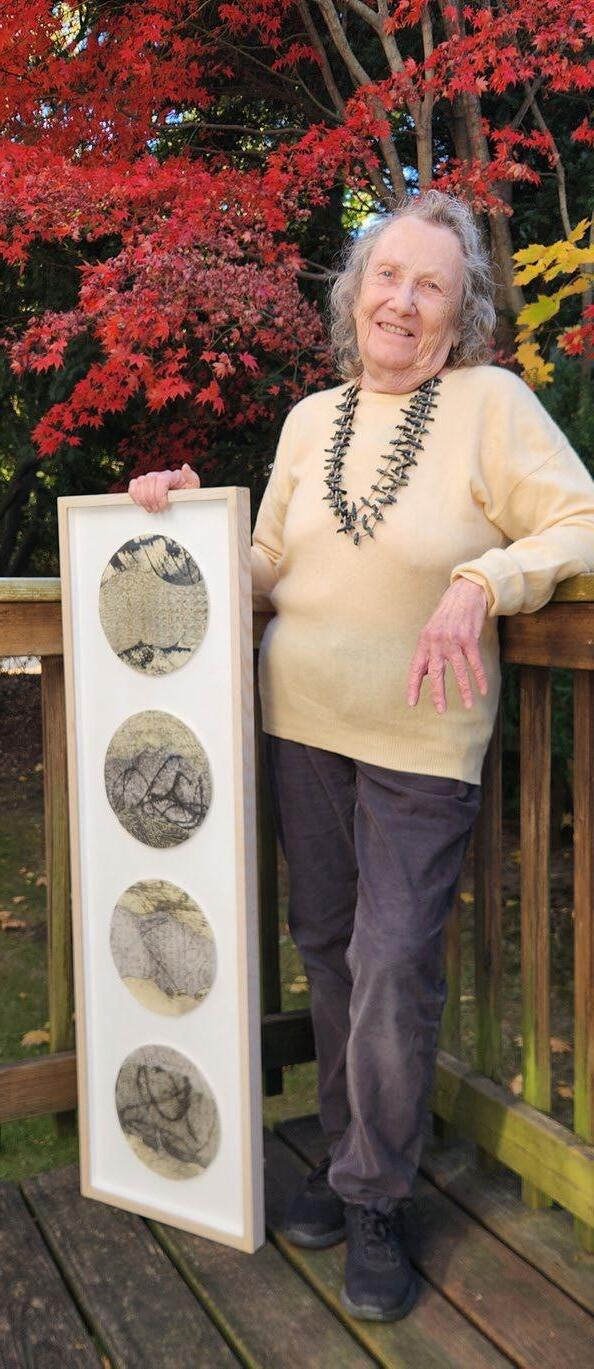
Together, donors who had previously donated materials to Special Collections or works of art to Museums made financial gifts of support towards the long-term care of these items. These gifts support the processing, cataloging and care of materials for future generations. We extend a special thank you to Kristine A. Mulhorn, Ph.D. and Ayumu Yokoyama, Ph.D., who supported their previous gift of two paintings by Tokujiro Nishi to Museums with a financial gift.
The Friends made their annual gift to support the acquisition and care of rare and unique items for Special Collections. This $100,000 gift supports scholarship in multiple disciplines that utilize Special Collections materials in their research. In addition, the Friends donated $50,000 as part of their $277,000 commitment towards the digitization of items related to Delaware history. Twelve full collections have already been digitized including historic Wilmington city directories, Delaware desegregation papers and the Lewis family papers, which includes one of the earliest maps of Newark. These digitized collections are available to the public through the Library, Museums and Press website.
On I Heart UD Giving Day, 62 donors raised $3,726 to expand the slate of “Stress Less” programming and resources available to students during this school year’s fall and spring semester finals weeks. Thanks to their collective generosity, stress-less programming for the 2023-2024 academic year will include visits from therapy dogs, yoga, visits from YouDee, free pizza and chair massages.
We are grateful for our Delaware Diamond Society donors who made a gift of $1,000 or more to the Library, Museums and Press over the past fiscal year. Your leadership-level support advances our ability to provide access to scholastic materials, facilitate training opportunities and provide meaningful student employment.
Robert W. Jr. ’66 ’69M and Margaret S. Abbott
Deborah C. and William D. Andrews
Mary C. Biondi Moran
Anita D. Biondi
Janet Ferber Brown ’74
Susan Brynteson
Nancy Newton Burri ’53
Joan Weiss Digby ’65M
Thomas J. Duszak ’75
Ashley M. Evans ’13
Donald Farren
Ronald M. Finch ’56
Perri B. Freeman ’93
Friends of the University of Delaware Library
Charles F. Jr. ’55M ’13H and Marlene S. Hummel
Joan Parker Johnson-Wedel ’65 and Alfred R. Wedel
Mary Hopkinson Knobelspiesse ’67 and Ernest A. Knobelspiesse ’67 Korshak Family, LLC
Stephen D. and Alma Korshak
Mark Samuels Lasner
The Lincoln Club of Delaware
Jean Jaquette Luce ’60
Ryan W. Maple ’00 and Christi Michaelson Maple ’02
Bessie Davis McAneny ’84M and Neil G. McAneny ’66
Kristine A. Mulhorn ’97PhD and Ayumu Yokoyama
Katherine Connare Murray ’90 and Timothy D. Murray
Thomas G. Preston ’67
Edward C. Ratledge ’71 ’72M
Raymond W. Kirkbride Memorial Trust
W. Eric ’69 and Judith E. Roberson
Louis E. Roemer ’55 ’63M ’67PhD
Andrea Stokes Scott ’71 and H. Rodney Scott
David S. Swayze and Carolyn H. De Pew-Swayze
Donald A. Taglialatella ’90
Nicole C. Vicinanza ’89 and David P. Arnott ’89
Estate of Fred Weinstein ’58*
Donna Dunning Witham ’70 and William L. Witham Jr. ’70
Deceased individuals are noted with an asterisk (*)
Library, Museums and Press
181 South College Avenue
Newark, DE 19717-5267 UNIVERSITY OF DELAWARE LIBRARY, MUSEUMS AND PRESS
Office of the Vice Provost 181 South College Ave. Newark, DE 19717-5267 library.udel.edu | 302-831-2965 @UDLibrary
